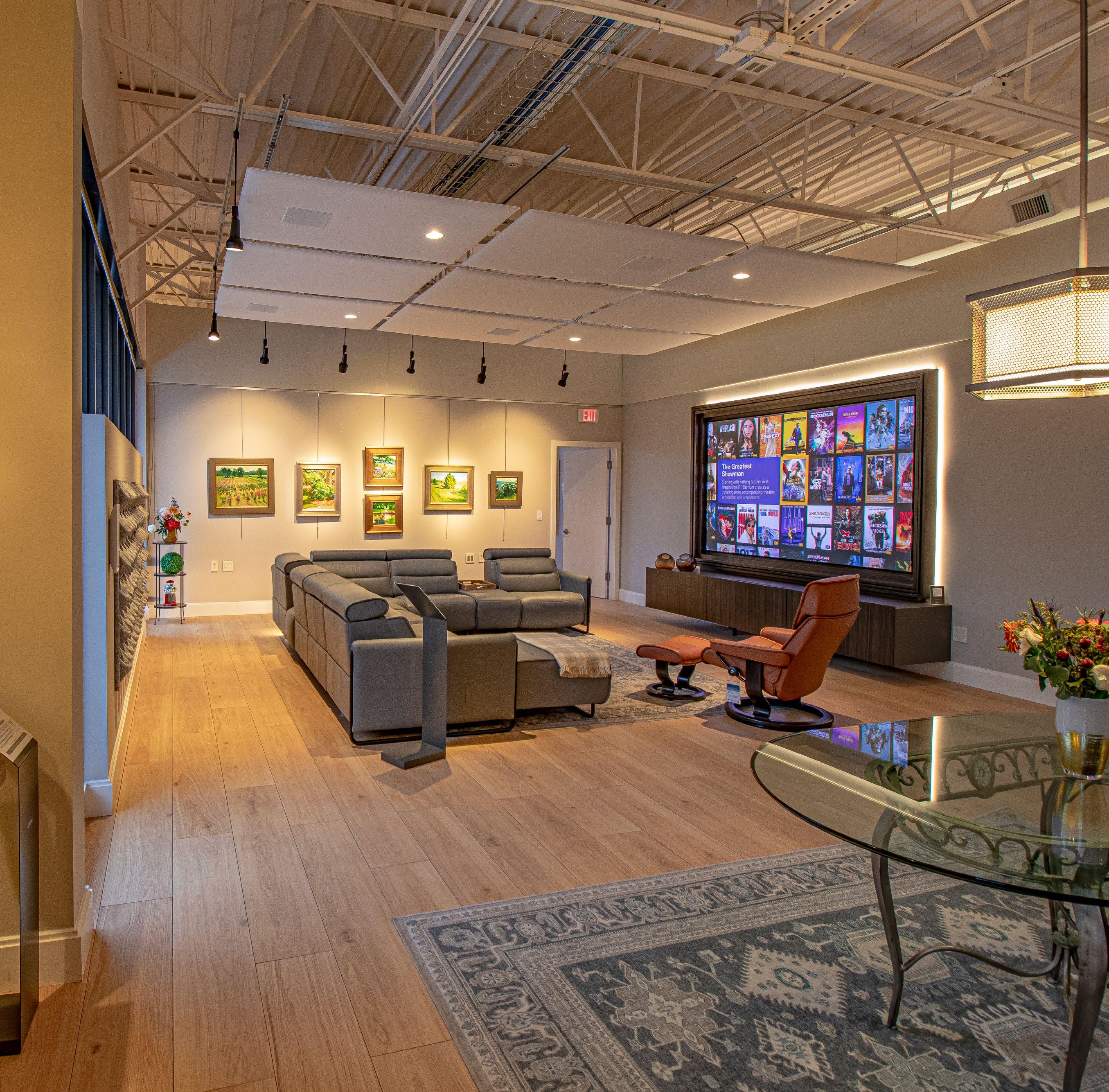
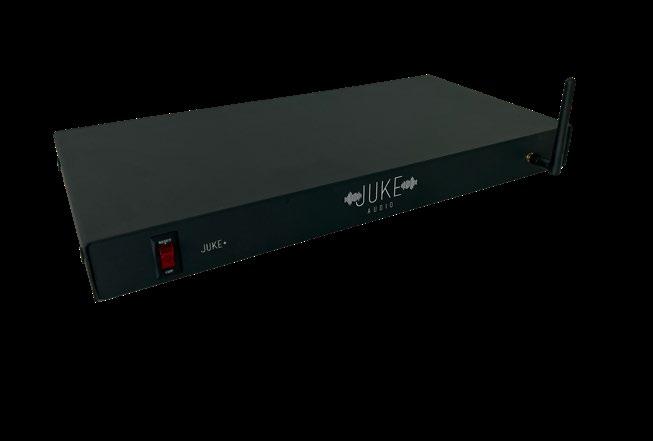
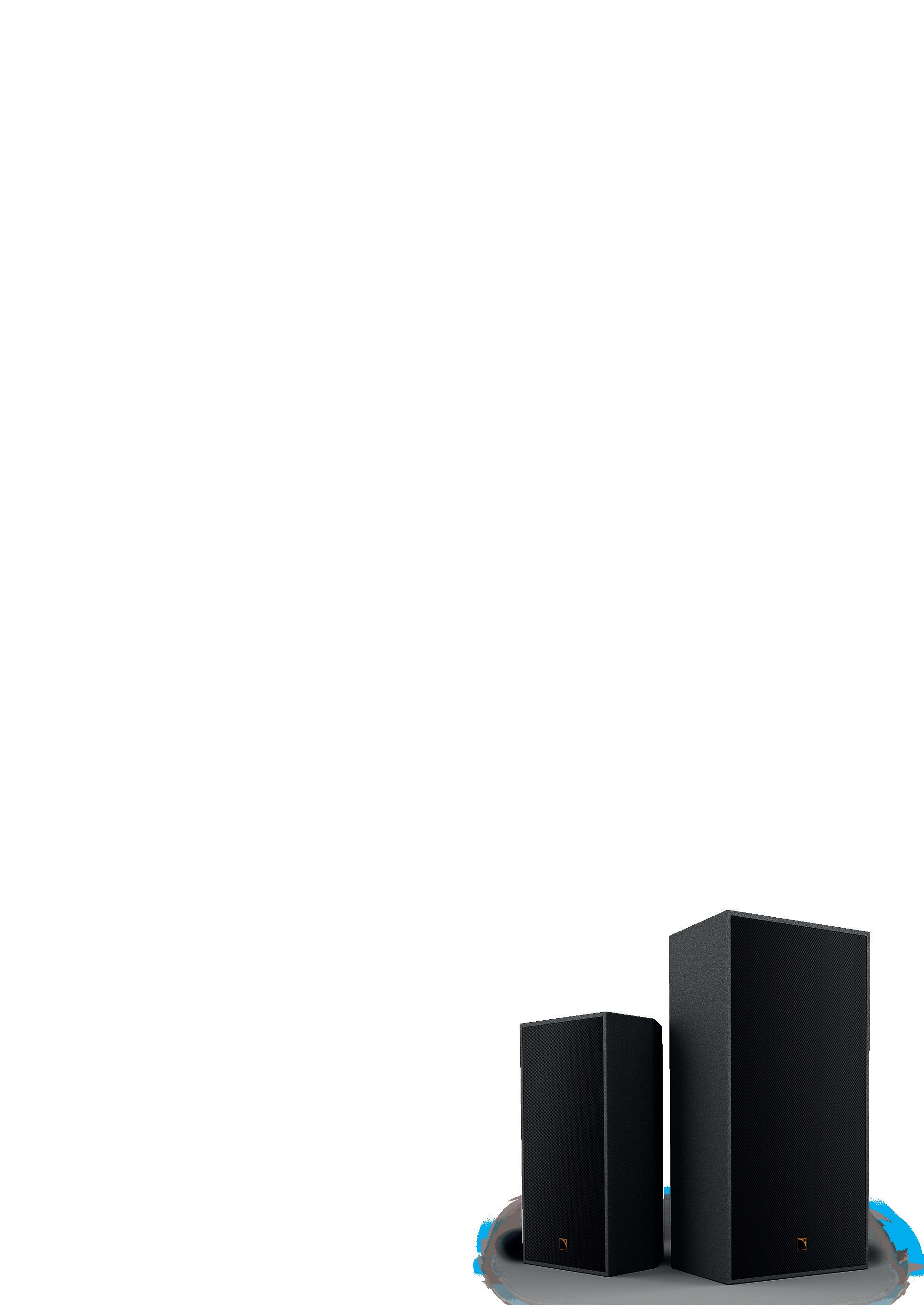

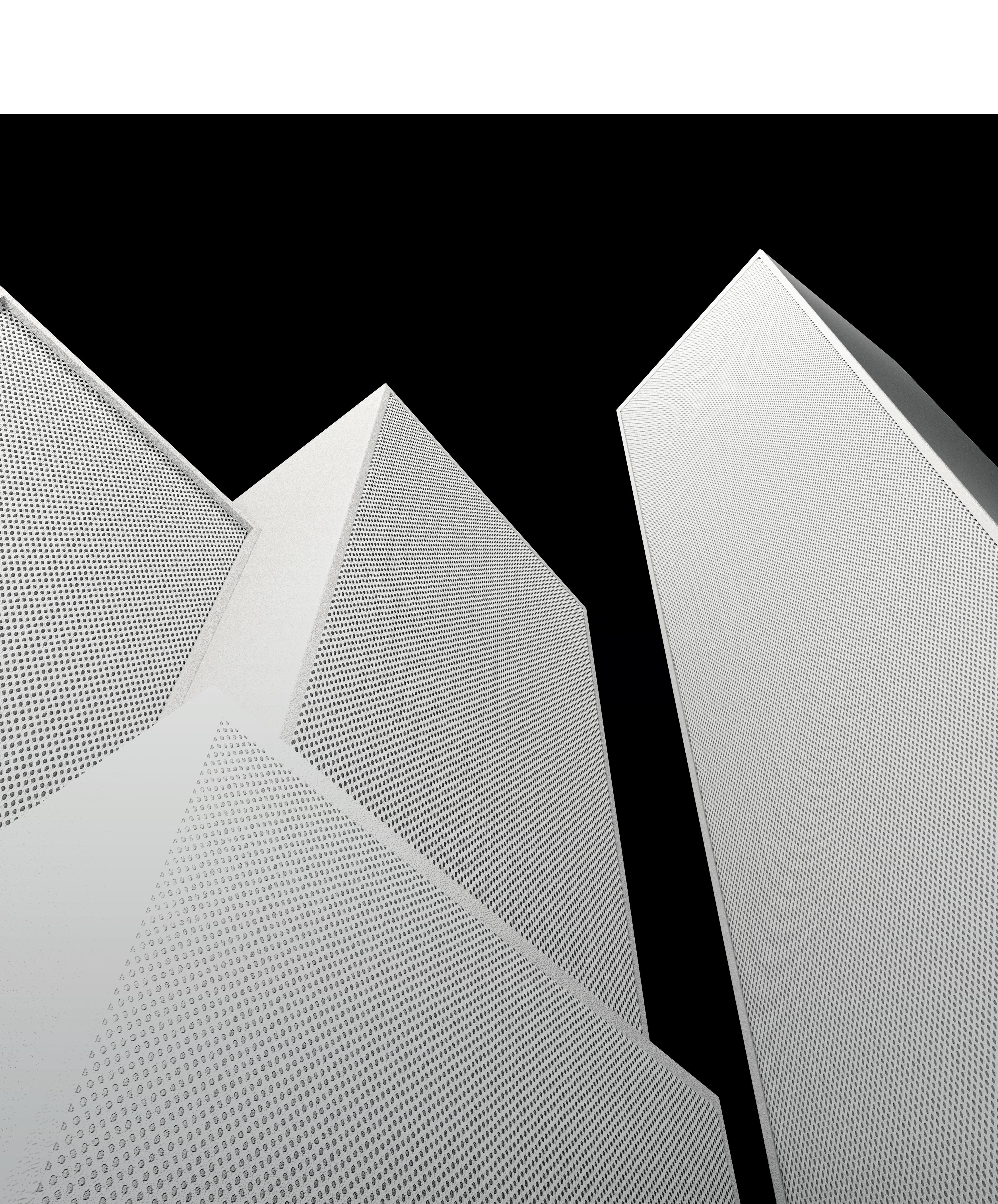
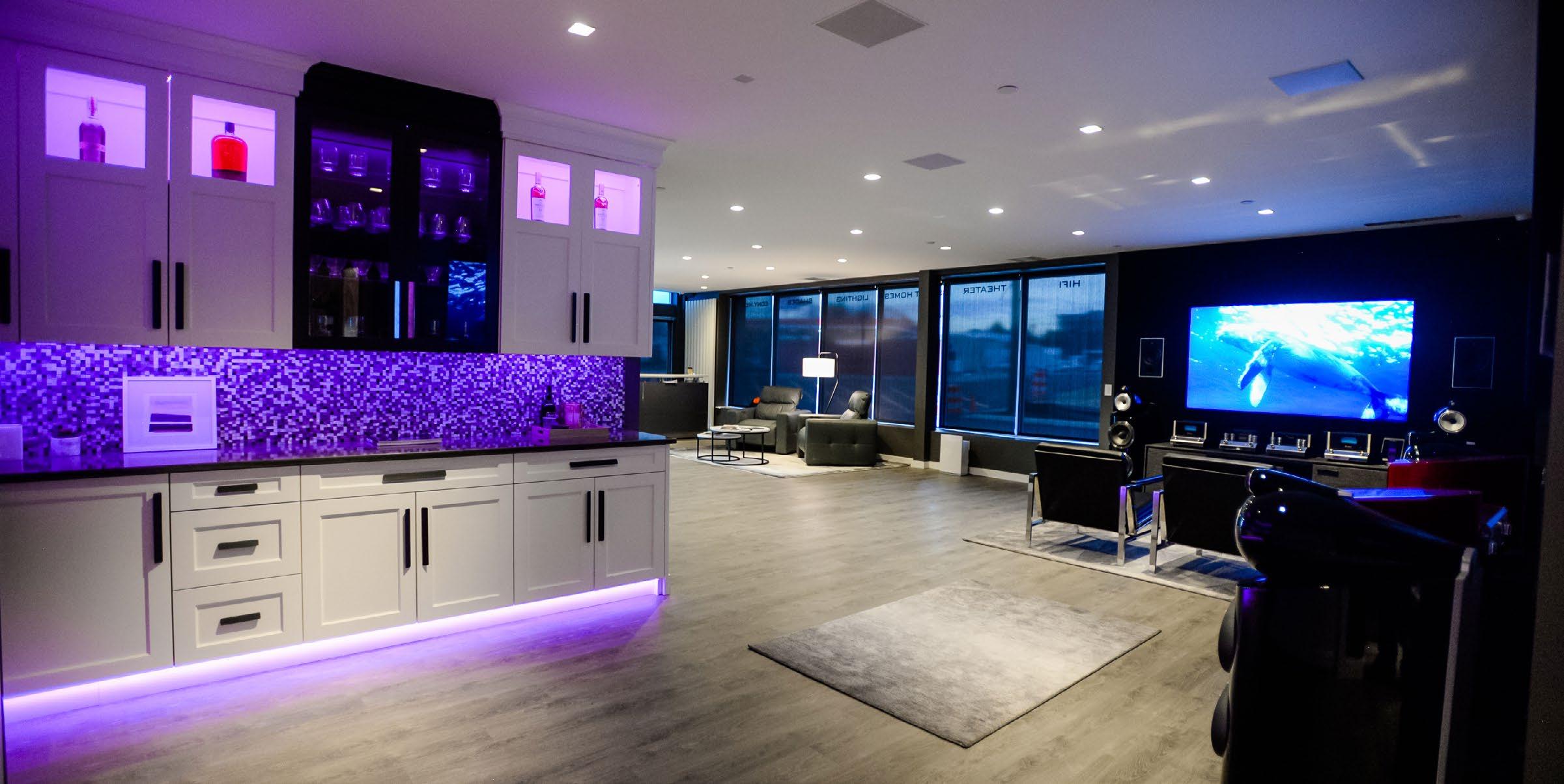







6 Secrets of Success
Making Tech and Design Relatable
Homeowners, property managers, and design-build professionals find great value in seeing tech in design-forward environments that illustrate what’s possible.
By Katye McGregor Bennett9 VITAL Business Tips
Lighting Business Strategies
What is the most impactful way to add lighting fixtures to your custom installation company?
By Matt Bernath
10 Back to Business
AI Has Arrived. Now What?
Take these steps now or risk being left behind.
By Jason Griffing12 Home Theater
Better Than Guessing
Eight rules of thumb in addressing the most common topics covered in a home theater meeting.
By Anthony Grimani34 Going Forward
Busting Common
Power Management Myths
A reality check on one of the hottest — yet largely misunderstood — segments of the home systems business.
By Joe Piccirilli, CEO and founder,RoseWater Energy
24 Tech Showcase
Architectural Speakers
For when audio is meant to be heard and not seen.
30 Review
Juke Audio Juke+
Whole-Home Audio Streamer
The Juke 6 review is by far-andaway the most clicked-on review on residentialsystems.com. So, clearly, we owed it to those people looking for fresh Juke information to bring in the Juke+ for a full hands-on!
By John Sciacca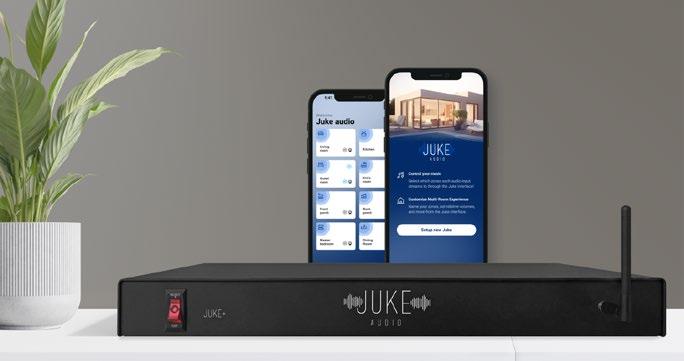
14 Banking on Boca Tech
Boca Tech and Automation launches a major upgrade to its sprawling 8600-square-foot former bank-turned-experience center.
By Anthony Savona
18 Showroom Showcase 2024
Our annual look at some stellar demo spaces from around the country.
22 Watching Daisy Grow
The first nationwide custom integration franchise is quickly building momentum — and attracting top industry firms. By Anthony Savona
26 The Integration Guide to Selling Lighting Fixtures
Lessons Learned in Lighting Dealers share some of their knowledge about the best ways to present lighting fixtures to trade partners and clients. By Karen Mitchell












The Consumer Technology Association (CTA) recently released a survey it had conducted concerning Gen Z and their technology habits. Gen Z, which the report puts between 11 and 26 years old, is currently the second largest population group (69.7 M), lagging slightly behind Millennials (70.7 M). As they move firmly into adulthood over the next 10 years, Gen Z will have a big impact on our businesses, and I thought the survey had some interesting — and hopeful — findings that I will share here.
The main takeaway for me from this survey is that Gen Z has the best relationship with technology above all other generations. They grew up with it, they get how it works, and, most importantly, they value it. To quote the CTA’s survey presentation: “For Gen Z, technology is more essential to their daily lives, it makes them feel good, and it’s an outlet for self-expression.”
They are also early adopters of new technologies and take pride in both having something first and recommending it to others. This ties in with social media being a key source of technology information for them.
Unsurprisingly, personal electronics are a big deal for Gen Z — namely smartphones, laptops, and earbuds. What was surprising to me, however, was how much they value quality in their products. The majority of Gen Z survey respondents said they would be willing to spend more for a higherquality product. That goes for content as well — their main concerns in selecting a streaming service are the quality of the content and ease of use.
Gen Z also has an appetite for subscription services, with the average person having nine platforms, compared to eight for Millennials, six for Gen X, and four for Boomers.
Of course, like Millennials and every other generation before them, Gen Z’s tastes, interests, and behaviors will continue to evolve as they get older and gather more life experiences. But I think this current baseline bodes well for the custom installation industry.
Having a knowledge and respect for technology is a great way for future clients to start off. The fact that they can work a smartphone like nobody’s business will only help with their use of home control systems, whether they want touchpanels or are comfortable using multiple apps. We fight the

multipleapp system now, but who knows what will happen when you get a generation that finds app-switching to be old hat and possibly even comforting.
The desire for quality, even at this young age, is another remarkable attribute. Let’s hope this one continues because if they think Apple AirPods are the ultimate in sound, just wait until they get their first Meridian speaker demo! And quality in streaming services? Better stock up on Kaleidescape movie servers.
Finally, unflinching at signing up for subscription services will make your selling service plans that much easier — and even expected.
I know I tend to sit on the optimistic side of the fence, and I am sure there will be challenges in reaching and converting all those techcomfortable, valueseeking young adults into paying customers, but all those attributes indicate a good place to start from.
Plus, it also sounds like Gen Z would make great employees, as well as clients.

KATYE MCGREGOR BENNETT
Katye McGregor Bennett is chief strategist and CEO of KMB Communications and an avid podcaster. Podcasts include Connecting Tech + Design and AV Trade Talk.
MATT BERNATH
Matt Bernath is a CE veteran with more than two decades in retail, wholesale, CI, and business coaching. In 2021, Matt and a group of partners acquired VITAL, and Matt now serves as the company’s president/CEO.
JASON GRIFFING
Jason Griffing is the director of product at OneVision Resources and the co-host of weekly home technology podcast found at HomeTech.fm jason.griffing@onevisionresources.com
ANTHONY GRIMANI
Anthony Grimani is president of Performance Media Industries, an acoustical engineering firm specializing in home theater design and calibration with offices in San Francisco, Los Angeles, and Paris, France. agrimani@pmiltd.com
KAREN MITCHELL
Karen Mitchell is a freelance writer based in Boulder, CO. She has written about the AV industry from both sides now — residential and commercial — for several years and still finds it most intriguing and fast paced.
JOHN SCIACCA
John Sciacca is a principal with Custom Theater and Audio, in Myrtle Beach, South Carolina. In his free time, he blogs prolifically about the CE industry. cineluxe.com








Homeowners, property managers, and design-build professionals find great value in seeing tech in designforward environments that illustrate what’s possible.BY KATYE MCGREGOR BENNETT, KMB COMMUNICATIONS
Showrooms and experience centers are certainly not new concepts for our community. However, the way the model has changed over the years brings to light some compelling opportunities that more in the channel can take advantage of. This issue of Residential Systems is chock-full of inspiration. Keeping with that theme, for this month’s column I wanted to talk about a few notable examples I’ve witnessed firsthand and what makes them special.
SAV Digital Environments is a luxury home technology firm based in Bozeman, Mont. The firm caters to high-end clientele and works very closely with adjacent trades, as well as artists, photographers, and other creatives. The company’s Wallace Ave. showroom in downtown Bozeman is co-located with an architecture firm and an art gallery. The facility is often used for events, and many include a combination of tech and design.
“Events play a crucial role in uniting the design-build-integration trades, fostering collaboration, and enhancing a shared understanding of each other’s trades. Through shared learning experiences, we gain a deeper appreciation for the unique contributions each offers in crafting exceptional environments. Having a space that mirrors our capabilities is paramount to showcasing our collective achievements,” says Scott Abel, VP of marketing & creative direction for SAV Digital Environments, who is also now the communications chair for the NKBA Big Sky Chapter.
Recently, SAV hosted the NKBA Big Sky Chapter Spring Meeting with brands Sonance, MagnaTrack outdoor screens, and Emtek offering CEU courses throughout the day. Lutron shared its Designer Series presentation as an educational walk-through of the facility, showing attendees how Ketra lighting brings out the best in artwork, finishes, and surfaces. A lively “find the invisible speakers” game showed designers how to hide audio in walls, and Leon Ente Soundtiles showed them how to showcase audio as art.
The day offered equal parts education, inspiration, and networking. I witnessed a room of interested, intrigued, and newly inspired design-build professionals who asked thoughtful, challenging questions. Presenters provided equally thoughtful responses, and, together, everyone learned quite a lot about design-forward tech and how to integrate it into future design considerations. A few site visits were scheduled as a result, which suggests the longer-term benefits of providing these types of spaces to the adjacent trades for their meetings and events.
Innovative Consulting & Marketing Inc. is a rep firm covering Arizona, Southern Nevada, New Mexico, and El Paso. The team recently opened a gorgeous two-story design and experience center in Scottsdale, Ariz., featuring design-centric brands like Leon, Samsung, Meridian, Lutron, Ketra, Ilu-

minii, Josh, MP Lighting, RoseWater Energy, Origin Acoustics, and others. Local artists’ work is presented alongside tech, and a curated tour includes a lighting demo that illustrates the power of light and the amazing results that can be achieved with thoughtful lighting design and the right application of tech. Principal Patrick Boyer led a portion of our tour after Lightapalooza and shared his successful approach to showing design-build pros how lighting solutions like Ketra can “fix” otherwise costly mistakes that can result in delays and added expense for clients.
Last year, Brilliant AV opened the Brilliant Experience Center in Costa Mesa, Calif., during a catered event attended by more than 200 people. Designed for consumers, property managers, design-build professionals, and trade partners, the layout of the 3000-square-foot “education facility” provides a range of experiences and showcases solutions for “smart homes and smart offices.” Brilliant tours typically take 45 to 60 minutes and include interactive engagement with audio, video, lighting, and control systems, and the facility is available to others for events, training, or design consultation meetings.
Brilliant is now part of Daisy, as is cyberManor in Los Gatos and others across the U.S. cyberManor smartly converted a charming century-old home into a livable, enjoyable smart home that is listed on Airbnb and is used to showcase how tech can be integrated to be simple, enjoyable, and beautiful all at once. (Scoop drop: Daisy will soon announce several new branches and is eager to add to its nationwide footprint. Contact me if you want to get “in” on this.)
Scoop drop #2. The Quantum Theater RED Studios Hollywood will be completed this summer and offered as a very exclusive demo space to interested clientele and industry partners. For those of you who have witnessed a Quantum Media Systems demo at CEDIA Expo, you know what this is like. John Sciacca has twice called it one of the best he’s ever seen. I am stoked beyond words to be an industry partner for this brand and can’t wait to see this theater and the demo they offer in person!
Bottom line. If you build it, they will come. But, you need to work your contacts and get more active at the local and chapter level of the trade associations that intersect with the work you do if you want them to come not only early, but often. Does that last sentence sound familiar? It should. The integration community is begging to be involved early and often, and this is a great way to make sure that happens.
Need help connecting with design-build pros or need help with your comms strategies? I’m here to help. Drop me a line at kmb@kmbcomm.com and let’s have that conversation.
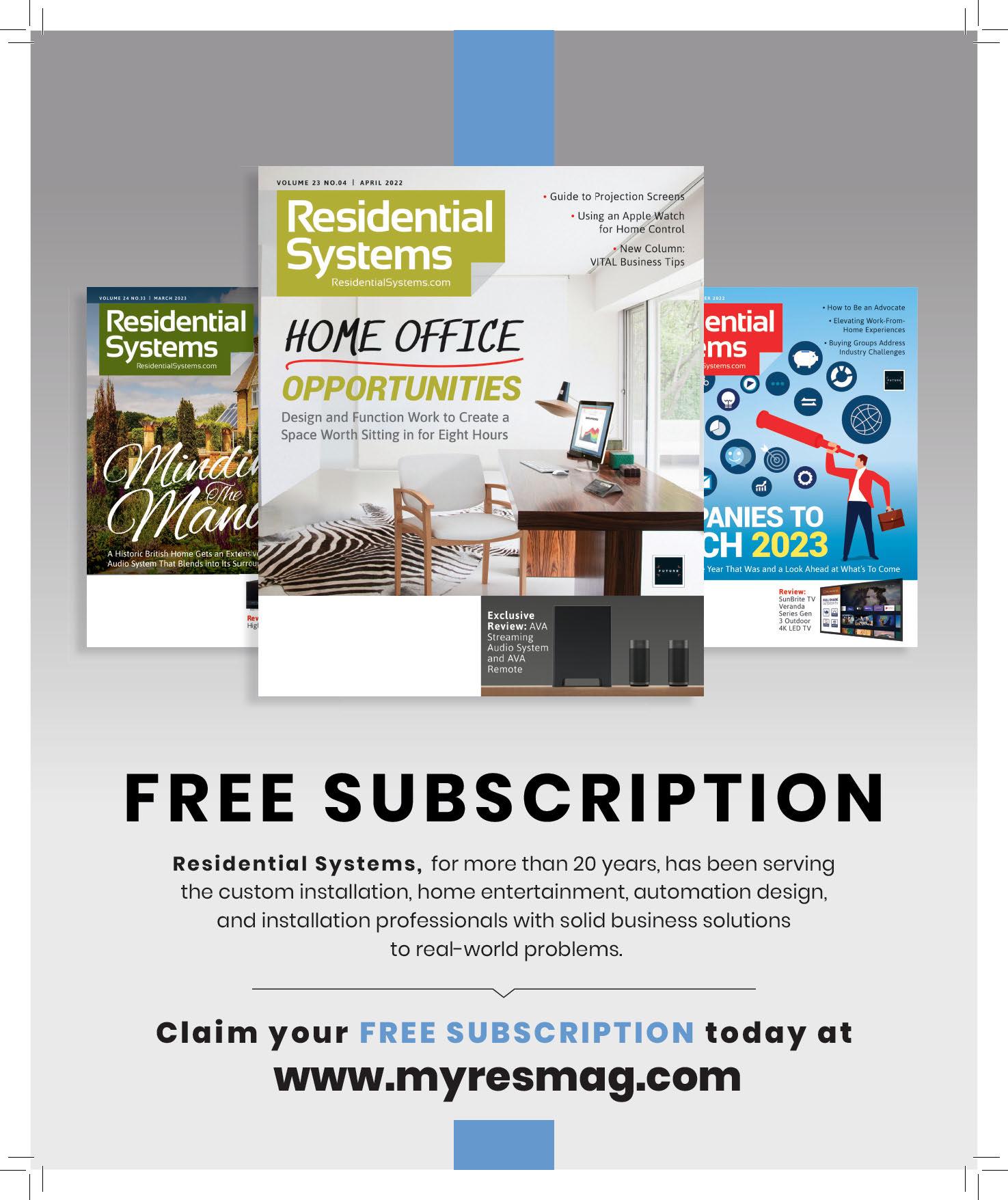
What is the most impactful way to add lighting fixtures to your custom installation company?
BY MATT BERNATH[EDITOR’S NOTE: A longer version of this article appears in the Residential Lighting Best Practices Guide, which is still available at residentialsystems.com under the “Resources” tab.]
There are several ways for custom installation businesses to add lighting capabilities to their product and service roster. Here are the strategies in the market that have proven to be the most successful.
Retrofit is one of the market strategies that is easy to enter and there is a massive addressable market of all existing homes. You have the ability to leverage your existing customer base. It is a simple market to enter with many innovative products that are easy to install and require very little lighting design expertise.
The challenges you face in this market include a huge list of competitors from Amazon to home stores to handymen and DIY. Retrofit lighting is also not a big differentiator, and with any retrofit project, there will be unforeseen complexity in a certain percentage of projects.
It might seem odd at first to think about landscape, accent lighting, or tape lighting as a separate business model. It can be a very lucrative first step into selling the idea of better lighting to a client. These systems can be relatively easy to install, hard to screw up, and provide a WOW factor beyond the cost.
While the potential market is also large, there will be great competition, including the standard of “what good looks like.” Some level of client education is required to overcome the fact that this category is considered a luxury to some.
The business model of upgrading lighting in a new-construction environment is where things get a little more complex. Upgrades refer to a market model of upgrading fixtures on a custom home project, where you educate and offer better fixtures in place of what was specified, without a full redesign. These can be very high-dollar projects that allow you to become a trusted advisor and deepen partner relationships.
This is where you need to have some lighting design expertise in-house or outsourced and carefully navigate the relationship between designer, client, builder, and electrician. Get these things right and this can be a very nice entry into full design-build projects. Get them wrong and you can make enemies quickly with other trades who also have a reputation and profit interest.
Full design-build projects are where your company creates the lighting plan for the

project and executes on selling the fixtures, and possibly more. These projects have the greatest risk and most potential reward, one of those being that you get introduced much earlier to these projects. Assuming you become very skilled and develop a solid reputation, your company will have less competition. A requirement for that reputation is managing projects well and staying on top of trends.
On the challenging side, the long sales and project cycles can present cash flow and personnel challenges you may not be used to. Also, to maintain your expertise and market share, you will need to invest heavily in ongoing education and the right staff to design and complete these top-level projects with the highest of standards.
While each of these models has different success factors and pitfalls, here are some foundational ideas to consider as you grow your lighting business.
• Diversify offerings: Diversifying what you offer could include choosing to eventually implement all the market strategies discussed, along with various fixture types, controls, etc. Become an expert at each stage before adding something new.
• Upsell to better stuff: Just like the AV and controls world, lighting fixtures come in various ranges of quality. Sell better stuff at a higher margin; it’s a win-win for you and the client.
• Add project management, design, and maintenance services: Adding services is key to profitability and differentiation. Outdoor lighting maintenance services are low-hanging fruit. Design and project management services are key to winning and delivering a great outcome. You will find that great lighting systems require deep integration with the project team from start to finish, often with many more design and project management hours than anticipated. A move toward “retainer”-based services should be considered versus fixed-pricing.
• Go deeper with brands: Going deeper with the brands you carry allows for the best pricing and drives higher margins, not to mention reciprocation of support from those brands.
• Right light, right spot: Put the right lights in the right spots…do you need fully tunable lighting in the laundry rooms? Don’t always shoot for the home run on every project.
• Mindful of metrics: With any new category, it’s important to be mindful of your metrics to determine what is working and what is not. You need to know the profitability of this category on your P&L and carefully track inventory. You also need to know the number of incoming leads, close ratio, job size, and all your sales metrics. This is key to determining where to focus for the highest leverage.
For information on the services VITAL provides, visit http://growwithVITAL.com.

Take these steps now or risk being left behind.BY JASON GRIFFING
I recently spoke with a friend who works at a large AI company. He said there are three types of people in the world:
• Those working full-time on AI
• Those actively experimenting with AI
• And those who have no idea what’s about to hit them
Artificial intelligence is the real deal, poised to turn everything we know about business on its head. And the CI channel will be no exception. In the months and years to come, we can expect:
• Sophisticated chatbots that can resolve complex customer issues
• “Co-pilot” apps that will train and assist our teams in real-time
• Proposal tools that will generate personalized estimates with the click of a button
• Financial analysis platforms that will spot trends and identify issues and opportunities in our books
• And a host of other AI-powered solutions no one has imagined yet There will be winners and losers in this game. If you want to come out on top, there are a few things you can start doing right now.
AI has exploded into mainstream awareness, but many people I speak with have barely engaged with these tools. So, if you are looking to build a head start, getting some hands-on experience is a no-brainer.
OpenAI’s ChatGPT, Google’s Gemini, and Anthropic’s Claude are all great entry points. They are ridiculously simple to use and they all offer free or lowcost plans.
Use your model of choice to brainstorm business development strategies, write a marketing email campaign, create a project management plan, analyze some financial data, or build a complex spreadsheet. The specifics don’t matter — building a sense of the capabilities and limitations does.
Finding ways to use these tools on a personal level will be easy, but really getting ahead of the curve with AI will require finding use cases to deploy across your organization.
For example, imagine a system that could send you a summary report of all actions taken in the field on a given day. Or being able to chat with a bot that understands everything happening in your sales pipeline. The possibilities are endless. The trick is getting specific. Focus on areas where AI can deliver real value to your unique business.
A helpful tip is to look for areas where large amounts of written language are routinely used; for example, customer service, sales communications, and project management correspondence. Anywhere the written word plays an important role will be ripe for the picking as large language models continue their advance.

Once you identify your target use cases, the next step is to think critically about the state of your internal company data. With all the hype surrounding emerging AI technologies, the importance of simple data hygiene is easy to overlook. But if you take one thing away from this piece, let it be this — if AI is an engine for your business, data is the fuel.
Unlocking AI’s full potential will require that tools like large language models can interact with your proprietary data. And if that data is stuck in people’s heads, scattered across various unorganized drives, or intermingled with outdated and inaccurate information, you will be at a serious disadvantage. So, audit your data processes:
• Ensure your CRM is being kept up to date
• Tighten up your project management documentation
• Ensure work orders are being filled out consistently
• Review your client system documentation practices
• Make sure you have a support ticketing system in place
The value of the data that lives in these systems will increase exponentially in the age of AI. Companies that recognize this now will have a significant head start.
AI will be a massively disruptive force that will tip the scales heavily in favor of those who move quickly to adopt it. But for all the hype surrounding this technology, it can be hard to know what steps to take right now. Taking the foundational actions outlined here will ensure that you and your company are poised to take the lead as the tools mature and the overall strategic landscape comes into focus.


Eight rules of thumb in addressing the most common topics covered in a home theater meeting.BY ANTHONY GRIMANI
You all know Groundhog Day, right? No, not the Bill Murray movie — the rather spurious method of determining the duration of chilly weather. All indications are that it has no scientific origin, but probably came out of repeated casual observations as a basic “rule of thumb” to help simplify a complicated thing like predicting the onset of spring. There are many other cases of “rule of thumb,” and even some in our very own industry.
While I would never advocate anything but solid engineering practices while seriously designing a high-end home theater, rules of thumb can be super-useful for situations like a client meet-and-greet where you thought the conversation was going to be about lighting, but suddenly the client started talking about home theater and how big the room is and how many seats they want and how big a screen they want...and suddenly you’re referring everything to “the engineers,” and that doesn’t make you look very prepared or competent. Now you’re wondering why you can’t just talk about lighting like you thought you were going to...
So, I’m here to save the day with some simple home theater design rules of thumb that will help you out of the jam and, unlike groundhogs, won’t leave you in worse shape than just guessing.
#1 How big should my screen be?
Quick answer: Screen width = 0.6 x room length
How did we get there? Based on the available resolution of 4K video, you can set up a screen that is big enough to cover a horizontal subtended viewing angle of 50 degrees. A bit of trigonometry will show you that the screen should be 0.93 x the viewing distance. A good place for the primary row is 0.68 x the room length in order to avoid serious standing wave nulls, and be at a reasonably even distance to all the speakers — 0.68 x 0.93 = 0.63. With rounding, that makes the screen width as 0.6 x room length.
Now...all rules of thumb break down if you don’t follow basic assumptions, and this one is no different. If the room is 50 feet long, and you’re only using the last 15 feet of it as the “home theater” (e.g., the rest is bar and game room), no, you don’t make the screen 30 feet wide
See what I mean? This isn’t sufficient for engineering the room (you need to be a lot more precise), but it can get you out of a tight spot in hurry.
Before we move on, I want to interject that our industry is falling back into the bad habit of talking about screen size in terms of diagonal instead of width. Stop that! Diagonal measurements are a cheat from the early days of TVs to make them appear larger. Anyone who is serious about big screens talks screen width. Whoever heard of a movie theater with a “43-foot diagonal” screen? No, movie theater screens are 40 feet wide or 60 feet wide or...you get the picture.
#2 How bright should my picture be?/How big a projector do I need?
Quick answer: Screen width x screen width x 11
How do we get there from here? The basic standard for illumination on

a screen is 20 fL. Starting out with a 1.0 gain screen with aspect ratio 1.78, you take the square footage of the screen (WxW/1.78), multiply it by 20, and you have pretty close to the projector lumen count for a 1.78 imaging panel. Now, I’m going to keep saying this: Do-not-use-this-to en-gin-eer- the-room. Once you get down to it, you may have a different shape screen, or a different gain screen, or some other unusual parameter that adjusts the numbers. That’s what engineering is for, and the client doesn’t need to know this. “Your projector needs to be about this big” is good enough for a client meeting.
#3 How loud do my speakers need to play?
Quick answer: For a 300 ft2 (or 3000 ft3) room, the speaker is going to play 7 dB less loud at the main seating position than the 1m anechoic sound pressure level specification.
For a 500 ft2 (or 6000 ft3) room, the speaker is going to play 10 dB less loud than the 1m spec.
For a 700 ft2 (or 9,000 ft3) room, the speaker is going to play 13 dB less loud than the 1m anechoic spec.
For a larger room, call me, because I want to work on your project! How do we get there from here? For starters, the burst (peak) SPL requirement for proper dynamics in a film soundtrack is 105 dB per speaker at the seats. You take the speaker’s 1m anechoic peak SPL and subtract the above values based on the room size. That will give you the speaker’s burst output at the seats in that room. If the number is equal to or larger than 105 dB, then the speaker will play loud enough.
For example: Brand X model Y has a burst SPL of 112 dB at 1m anechoic. The room is 3000 ft3. 112–7=105 dB, so that speaker is fine.
For this one to work, you’re going to need a little background info on the products you sell. That background info is the peak SPL at 1m (3 feet) anechoic. This is something you need to know, people! Not all you need to know, but definitely this much. It’s not necessarily the same as power handling, although you can use power handling and sensitivity to sort of get in the same Zip code as peak SPL in a pinch. The better approach is to deal with a speaker company that will give you the peak SPL data, such as Perlisten, Genelec, Pro Audio, and, well, my company Grimani Systems does, too. There are others.
Now...the more engineering-minded of you out there are going to want to know how I got those loss numbers. You’re going to notice that they’re not inverse square law loss. That is because that loss is for an anechoic or non-reflective environment. Home theaters are neither of those. It’s too complex to go into here, but the loss data involves the typical dispersion of speakers, the typical reflected energy, and the typical listening distance in a home theater environment of the specified size.
I’m going to keep reminding you that these are rules of thumb and not to be used for engineering, because I don’t want to hear in the halls of CEDIA, “But Anthony told me to just subtract...” Part of engineering is to make sure you properly specify the size of speakers and sound system you need. If you under
specify, which is the more common mistake, then something could melt and lead to costly repairs. If you over specify, you’re wasting money and size, and the client may very well go with a lower bid from your competition.
#4 How much acoustical treatment do I need?
Quick answer: About 15% coverage of room surfaces with absorption and about 10–15% with diffusion
How do we get there from here? The premise is that there is a target amount of reflected energy in the room that is pleasant — not too much, not too little. It also assumes a mostly carpeted floor and comfy seating. If those factors vary, the amount of acoustic treatment will also need to vary. This is not a substitute for a calculation of the room’s decay time and spectrum.
#5 How many seats can I have?
Quick answer: Number of rows = Room length x 0.09
How do we get there? We don’t want the front row to be closer than 0.45 x room length from the front wall. That leaves 0.55 x room length for all the rows. A nice recliner chair takes up about 6 feet of depth. 0.55/6 = 0.09
For the width, the number of seats across is a bit trickier. You would normally have a fixed reduction of 7.6 feet from the room’s width. This is necessary for two 6.5-inch widths of stretched fabric dress, two 36-inch aisles, and one 6-inch arm of a chair (long story…). That all adds up to 91 inches, which is equivalent to about 7.6 feet.
Once that’s taken care of, each lounger is about 2.33 feet wide (22-inch pad+6-inch Arm => 28 inches/12 = 2.33 feet).
Subtract 7.5 feet from room width, then divide by 2.33 for number of seats across.
For example, a 20-foot wide room would yield 20-7.6 = 12.4 feet.
12.4/2.33 = 5.3. So you can put five seats with 22-inch pads and 6-inch arms across a 20-foot home cinema with acoustical treatments, stretched fabric dress, and comfortable aisles.
#6 How tall should the risers (and how high should the ceiling) be?
Quick answer: 18 inches per riser
How do we get there? That seems like a lot, but when you run the calculations on a large 4K projection screen at the appropriate viewing height, you typically need that much height for the risers to avoid blocking sightlines.
Note that this is going to require extra height in the room, otherwise people are going to bump their heads on the ceiling at the back. Plan to enter the room at the back and have the home theater slab dug out 36 inches from the floor at entry level, like a swimming pool. This gives you two risers for three rows of seats, with the back row maintaining full height to the ceiling. Adjust as needed for the number of rows.
#7 What is a good shape for my room?
Quick answer: Room length x 1.2 to 1.35 of room width
How do we get there from here? Very long, narrow rooms do not sound good for a number of reasons, such as the necessity for the speakers to cramp the listeners. If a ratio of about 1.2 to 1.35 times length-to-width is maintained, appropriate spacing can be achieved.
Actually sizing the room during engineering is way more complicated than this, because you have to take into account standing waves. This ratio just gives you a starting point for a generally pleasing and good-sounding room, not necessarily the best modal distribution.
#8 How high should my screen be?
Quick answer: The screen mid-point should be no more than 3.25 feet + Viewing Distance *0.17 above the floor at the front row (all in feet)
How do we get there? This one is based on comfort and avoiding neck strain, pain, and headaches. In general, we go for no higher than 10 degrees up to the middle of the screen at the front row. SMPTE specifies 15 degrees as worst-case. Using a bit of trigonometry, add in the typical seated eye height of 3.25 feet, and there you go. Watching movies is fun, and we don’t want to injure anyone or cause them physical discomfort in the process. They may not even realize that looking up at the picture for long periods may be harmful in the long run. (Look how many people put their TVs above the fireplace.) You should look out for them.
There you have it. Eight rules of thumb to address some of the most commonly discussed topics in a home theater meeting. Hopefully, this will keep you ahead of the client...and avoid any unexpectedly “chilly weather.”
Anthony Grimani is co-founder of Grimani Systems loudspeakers (www. grimanisystems.com), and president of PMI Engineering (www.pmiltd.com) and MSR Acoustics (www.msr-inc.com). Chase Walton contributed to this column.
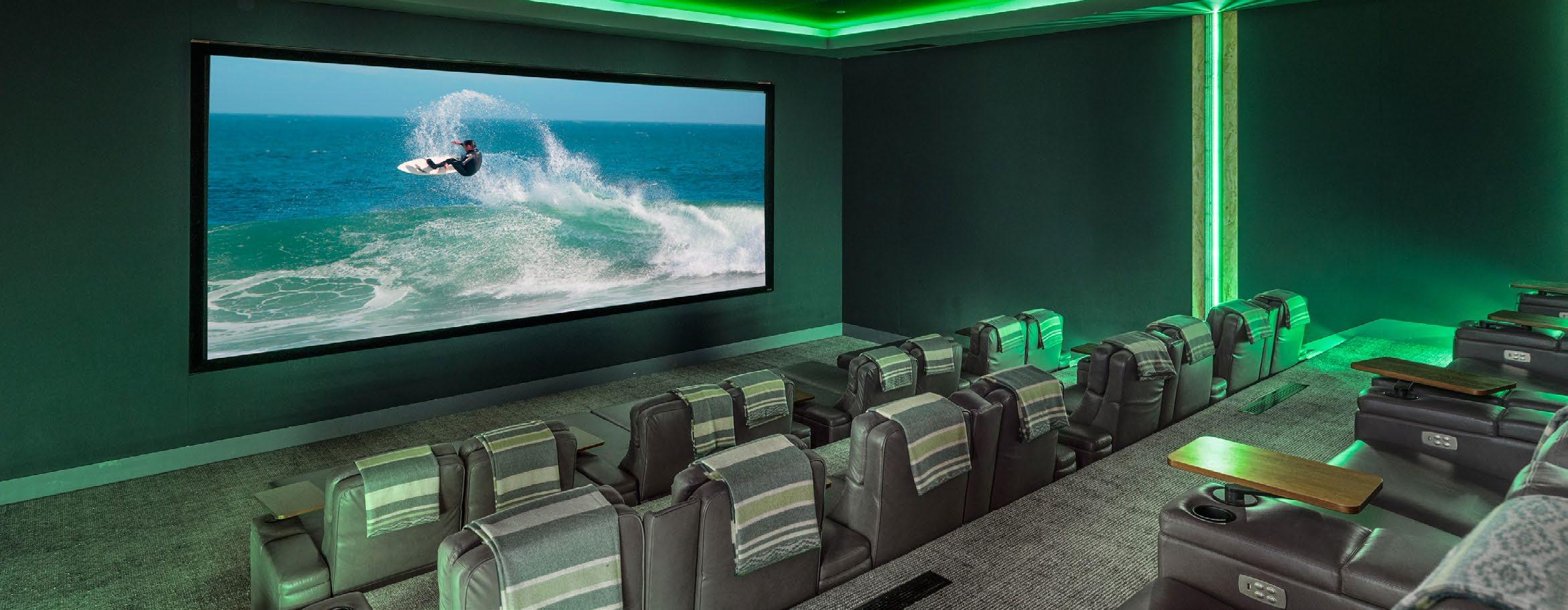


Boca Tech and Automation launches a major upgrade to its sprawling 8600-square-foot former bank-turned-experience center.By Anthony Savona
f a picture is worth 1000 words, then a great home technology demo is probably worth around 10,000. That presents a challenge when it comes to writing an article about the jam-packed, 8600-square-foot Boca Tech and Automation experience center located in Boca Raton, Fla., but here we go… Boca Tech owner Jeff Galea bought the building, which used to be a bank, in 2015. Not only did its former life give the Boca team a drive-up window and vault to play with, but it also sits on an acre of land with its own parking lot. And the flat roof on the single-story building made it perfect for placing solar panels, which Galea combined with the world’s first installed RoseWater Energy Group HUB power management system (serial number #0001).
IWith the facility closing in on its tenth anniversary, HTA Certified Boca Tech recently completed its third major technology update, including a complete redesign of the luxury home theater that is located in the former vault. The other bank attribute, the drive-up window area, has been enclosed to create a large garage where trucks can be loaded unaffected by Florida’s temperamental weather.
“This is the first building we owned, but we have built showrooms many times,” Galea says. “We approach the market in more of an R&D way than I think some of our peers do. I like to build out what we’re giving to our clients and live with it here so that when we have a problem, we have firsthand experience on how to fix it. We can see the problems before the clients see them.
“We built this space with three things in mind, the first being the R&D aspect of it,” he adds. “The second thing is to have the entire staff comfortable with the solutions. Every single employee desk has a touchpanel on it, and everybody has their own television as well as a RoseWater-backed-up workstation. When someone comes to the front door, we can answer the doorbell and open doors just like you would do in a house.
Number three is we wanted a showroom where each area looks like a place in your own home. Other than a bedroom, we have every room in the house — including a luxury kitchen and bathrooms.”
At the front entrance to the showroom, located next to the putting green and outdoor hurricane screen demo, is the first of four ballistic doors, which are all handmade and designed to match the aesthetics of the space while being able to withstand rounds from assault rifles (a fact we hope remains untested). As visitors approach the door, a voice welcomes them and, if unlocked, the heavy door opens with a slight push. If it is locked, the visitor can ring the Control4 video doorbell, which can be answered from any desk.
Stepping into the lobby, to the immediate right is the awards-and-news room, which features the company’s many accolades and feature stories. It also is the sitting room for the men’s and women’s bathrooms. The bathroom doors feature Lutron Ketra lights above them that remain green when the rooms are unoccupied and automatically turn red when the door is opened and someone enters. Inside, each bathroom features a touchpanel on the wall, a Séura Mirror TV with LED backlight, and subtle Trufig design touches throughout.
To the left of the entrance is the library, which features books that detail the company’s larger projects and show an example of the MegaMan, which is a completely sealed, air-conditioned equipment rack that Boca Tech has invented.
“It can go in a garage, it can go outside,” says Galea. “It’s completely sealed but completely accessible. We don’t have basements here to put racks in, so this solves the problem by letting us put them in the garage or outside.”
Next to the MegaMan is the equipment closet, part of which has gear that is tastefully exposed into the lobby area while the rest is tucked away behind the second ballistic door, this one


with a fingerprint reader. That is where the facility’s 40x40 AVPro Edge MXnet 10G video matrix lives, as well as all the gear for “The Vault,” Boca Tech’s reference theater, which is located on the other side of the building across from the front door.
“The farthest speakers from the equipment rack are just over 100 feet away, and that’s to prove you can build a luxury theater with reference-level equipment where the equipment doesn’t have to be right next to it,” says Galea. “All the noise, heat, and ventilation are far away from the actual space.”
Stepping further into the open space, the next area is the kitchen, which has a waterproof Séura Hydra TV on the wall near the sink and a pop-up Planar TV hidden in the island. Above this area are skylights that let natural light in, which, combined with the long, flat surface of the island, make it the ideal area for designers to see furniture and shade fabrics.
Just beyond the kitchen is the family room that, like all the other areas in the
showroom, features Stressless Furniture that Boca Tech distributes It also includes a 77-inch Sony Master Series OLED TV and a floating SoundWhere Ensemble cabinet that includes a 3.1 speaker system, backlighting, and local storage. The artwork hanging on the walls was created by Boca Tech and doubles as acoustic paneling. Next to the artwork is a large framed Séura mirror TV running a slideshow of SoundWhere cabinet installations.
Across the way is the conference room, which features an automatic door imported from Italy that opens and closes like an elevator. Once you are inside the room and the leather-wrapped door closes, the room gets very quiet, allowing its occupants to focus on the task at hand, which is typically working with clients or hosting educational sessions.
The conference room features a Cisco telepresence system, and any source in the building can be demoed on the screen. Anything being shown in the room can also be sent to any screen in the facility — or even all of them, as was done during the recent open house Boca Tech held for its clients and partners.
Outside the conference room is another media room area with a unique vapor fireplace that burns water to create a stunning visual effect, and a large SoundWhere Symphony cabinet with unique metal finishes that include a 3.1 sound system and a 98-inch Sony TV.
The Vault reference theater is nearby, but Galea usually leaves that as the big finale of the tour, so we will do the same.
Like most places in the showroom, the hallway leading to the back area is packed with tech for clients to experience; on the left is the Lutron keypad display. “We’re really proud of this display because I can’t tell you how much of a pain it was to try and figure out what every single combination of keypads can do,” says Galea. “We have it set up so that people can see every style and they can experience what the feedback looks like on each model.”
On the opposite wall is Boca Tech’s 17-foot smart home simulator that covers
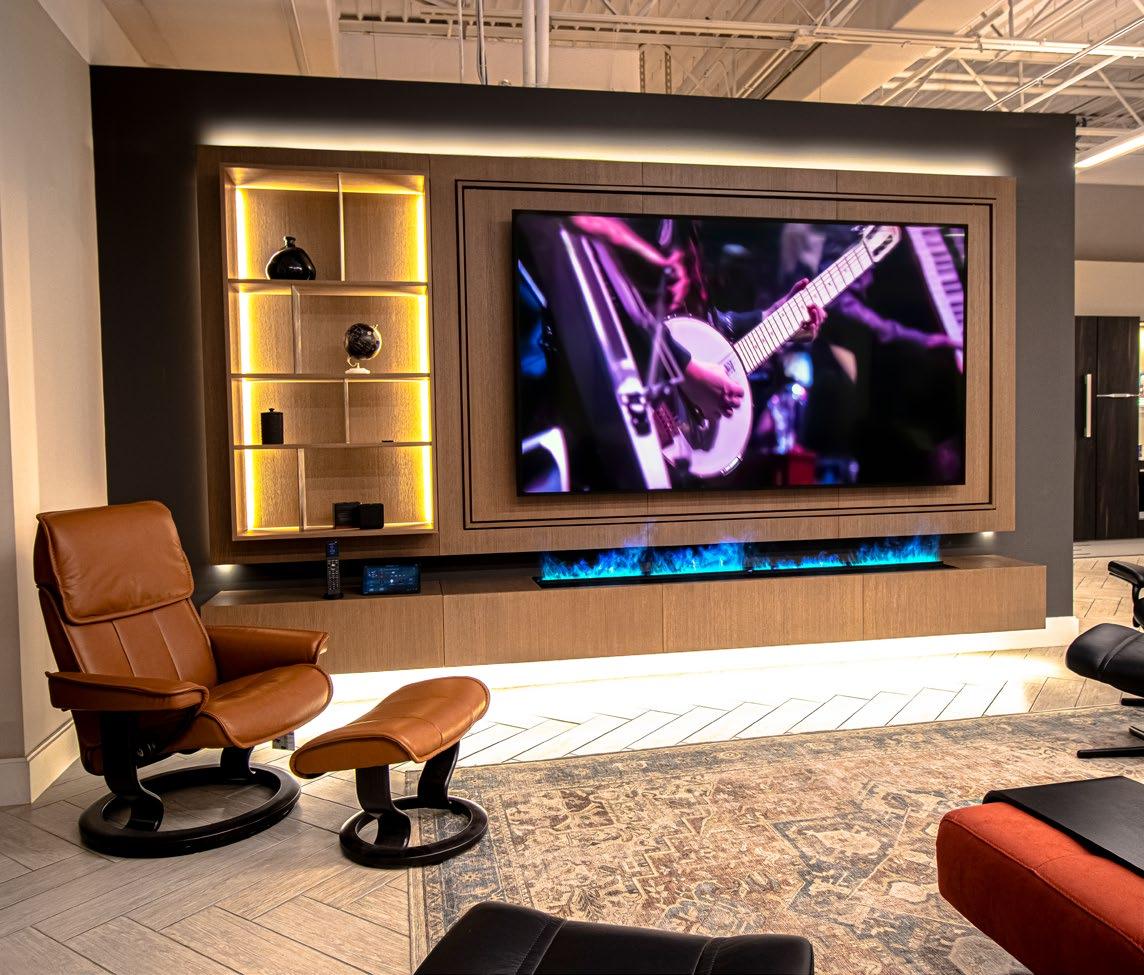
pretty much everything the company can do all in one space. It is a fully functional model that the team uses as a training tool, as well as a way to explain to clients the services that they provide.
“This simulator has four video zones, a controlled thermostat, 18 zones of lighting, and eight zones of audio,” says Galea. “We also have motorized shades going on in there. We can demonstrate the video doorbell so that when someone rings it, we can answer it on the touchpanel adjacent to the simulator.”
Walking beyond the hallway, clients experience the Lutron Ketra and Control4 certified showrooms. The large open space features Ketra lighting shown over a dining room area and in a media room space. Windows across the back of the room are covered by Lutron automated shades.
Before heading to the media room, clients can experience a Steinway-Lyngdorf demo in an alcove off the dining room setup and a 2-channel listening room off to the side. The 2-channel space has an Octave tube amplifier as well as KEF, Moon Audio, Vandersteen, and Dynaudio components.
The media room features a unique SoundWhere Short Throw cabinet that has a built-in compartment for the Samsung short-throw projector, which sits in front of a 120-inch Stewart Filmscreen Balon Edge screen. “This was engineered by us,” says Galea. “All of the projector’s optics are set for the right distances, so there is no adjustment being made to the picture. That’s why it is so unusually bright — even with the blinds open — and there is no fade when you move to the side.
“This is a 5.1.4 Dolby Atmos system — three in the front, two in the back, four speakers in the ceiling, and a subwoofer. We don’t have side speakers because in normal family rooms you have a kitchen on one side and you might have sliding doors out to your backyard on the other, but you do not have a left and right wall. We made this operate like a real-world room.
“I’ve sold this exact room with all the furniture as a package several times. The only thing we change is the color of the furniture.”
Past the back room is the third ballistic door that Boca Tech has — the employee entrance. It has its own video doorbell as well as remote locking/unlocking capability. Every employee has their own security card used to unlock the triple steel rods that secure the door when they arrive at work.
A few steps past that door is a room dedicated to the RoseWater system. “We have blueprints hanging on the wall that show how we designed the power system for the building,” says Galea. “We use green on the blueprints to show all
the RoseWater feeds, red to show surge-only, and black is what we call ‘dirty power.’ We have digital signage with a video explaining the system, as well. They can see our batteries, and then on the back wall we show them pictures of the solar panels that are on our roof.”
The back area also includes spaces for rack assembly, warehousing, and workspaces for Boca Tech’s team of on-staff engineers with a very large Planar 3x2 video wall that displays project calendars and key performance indicators, but those are not part of the client tours, so we’ll skip this area. This leads us back toward The Vault.
The Vault still has the sturdy door it used when the building was a bank, but it is strictly decorative now. It is propped open against the wall and bolted to the ground with the old mechanism visible through a Plexiglas front that Boca Tech retrofitted onto it. It still does play a part in security, however, as there is now a facial recognition screen embedded in it. Once it scans a face that is recognized, it slides open the fourth and final ballistic door to allow entry into The Vault.
Once you enter and the door closes behind you, the room is completely silent and sealed off from the world behind 18 inches of solid poured concrete — even the projector is completely isolated from the room in its own projection booth. If there were a hurricane outside, the people inside wouldn’t know it. With the RoseWater system, along with its own wireless access point, there would be no disruptions in power or connectivity.
“The seating is all Stressless with motorized recliners in the back row and a motorized sofa in the front,” says Galea. “We did eight layers of light in here, including focused lighting on the acoustic panels and recessed LED linears in the columns; but nothing gets onto the screen, which is very important in any theater, let alone a high-end reference theater.”
The room features a Barco Njord Cinemascope 5K UHD projector paired with a Stewart Filmscreen 200-inch Pure White matte reference screen. A Kaleidescape 4K UHD lossless movie player, a madVR Envy MK2 Extreme video processor, and the Njord’s DCI/P3 color space are responsible for the high-fidelity motion pictures available in The Vault. Audio is handled by a Trinnov AL32 audio processor, Dynaudio Studio speakers, and four 13-inch JL Audio Fathom subwoofers, culminating in a 11.4.13 Dolby Atmos setup.
The sound system is discreetly hidden from view, but Galea can press a button to turn on the lighted silhouettes of the speakers so the clients can see where they are located even if they can’t see the components themselves. “The demo in here is outstanding,” he says. “We spent a solid eight months on the renovation in this room alone, rebuilding it, making it bigger — and even making it ADAcompliant! This is truly a reference theater in every sense. It’s got the absolute best that we’re able to offer.”
Though this upgrade was only just completed, showrooms can’t stay static for long, a fact Galea is well aware of. “We’ve developed a streamlined process on how to be able to change a system throughout a long lifetime,” he explains. “Technology is going to evolve. You don’t need to replace everything, every time, but you’ve got to understand how it all works and set it up properly so that you won’t be stuck in the past.
“Upgrading our facility also helps with training. After all, no one starts from a clean slate — people are always bringing something with them from another house. You never get to make every single decision, so, you’ve got to figure out how to work in that world and be successful.”
For more information, visit bocatech.com.
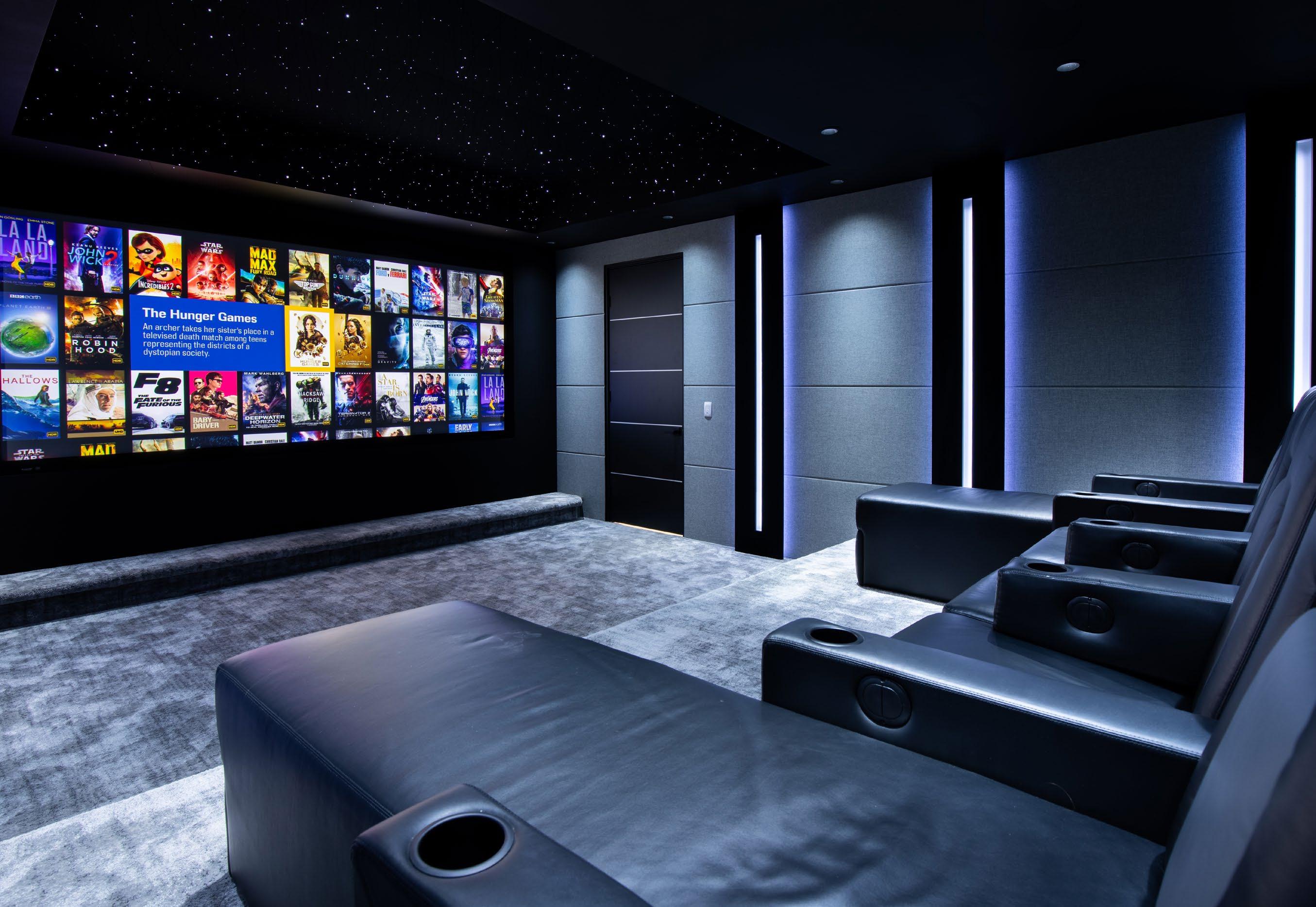
Our annual look at some stellar demo spaces from around the country.
We put out the call to “show us what you’ve got,” and these are the custom dealers who answered. For the fourth consecutive year we highlight some dynamic showrooms that show off all that this industry can offer.
Simply Automated
Website: sapgh.com
Location: Pittsburgh, Penn.
Showroom Dimensions: 6000 square feet of showroom and 3500 square feet of warehouse
Brands Featured: Control4, WAC/AiSPIRE, American Lighting/Proluxe, Mirus, JBL Synthesis, Sonance, James Loudspeaker, Paradigm, Anthem, Rega, Future Automation, Sony, LG, Simplified Acoustics, Hunter Douglas, Leon, Electric Mirror, madVR, Kaleidescape
Fun Fact: Simply Automated’s experience center features 6000 square feet of meticulously designed space showcasing the latest advancements in home automation, lighting technology, and entertainment. Clients and design partners discover a fully integrated experience with all aspects of Control4 integration throughout the space. Lighting design and specification is a core focus of our business and, as such, we s howcase the newest lighting technology from AiSPiRE, Proluxe, and Mirus throughout. Our 7.4.4 JBL Synthesis theater room offers an exhi larating experience that leaves clients wanting more and more.

Electronic Concepts
Website: ECNY.NET
Location: Rochelle Park, N.J.
HTA Certified
Showroom Dimensions: 3500 square feet
Brands Featured: Savant, Lutron, USAI, Magico, Meridian, Lyndgdof, Dagostiono, Grphon Audio, JL, DCS, Reflectel, Barco, Cinematech , James Loudspeaker
Fun Fact: We are the only dealer in all of New Jersey for Magico, DCS, and Gyphon Audio.
Innovative Consulting and Marketing Experience Center
Website: www.innovativeconsult.com
Location: Scottsdale, Ariz.
Showroom Dimensions: The Experience Center is 4500 square feet
Brands featured: Lutron Ketra and Finere lighting, Lutron Sivoia QS and Palladiom Wire-Free shades, Samsung displays, Leon speakers and TV concealment products, Origin Acoustics and Ambisonic speakers, AVPro video connectivity, AudioControl audio products, Fortress theater seating, Amina invisible speakers, and Josh.ai control
Fun Fact: The experience center used to be an audio-video distribution facility that we took down to the studs. The Innovative Consulting and Marketing Experience Center was built with specification in mind. The interior designer, lighting designer, and architect are often the first trades involved with the homeowner. Too many times, the AV Integrator is brought in after the budgets have been determined. We use the experience center to get in early and hold a place for the AV Integrator and the brands we represent. Once the homeowner and their design team see what is available to them, they are more willing to stretch the budget for the latest in lighting, shading, audio-video, and control.

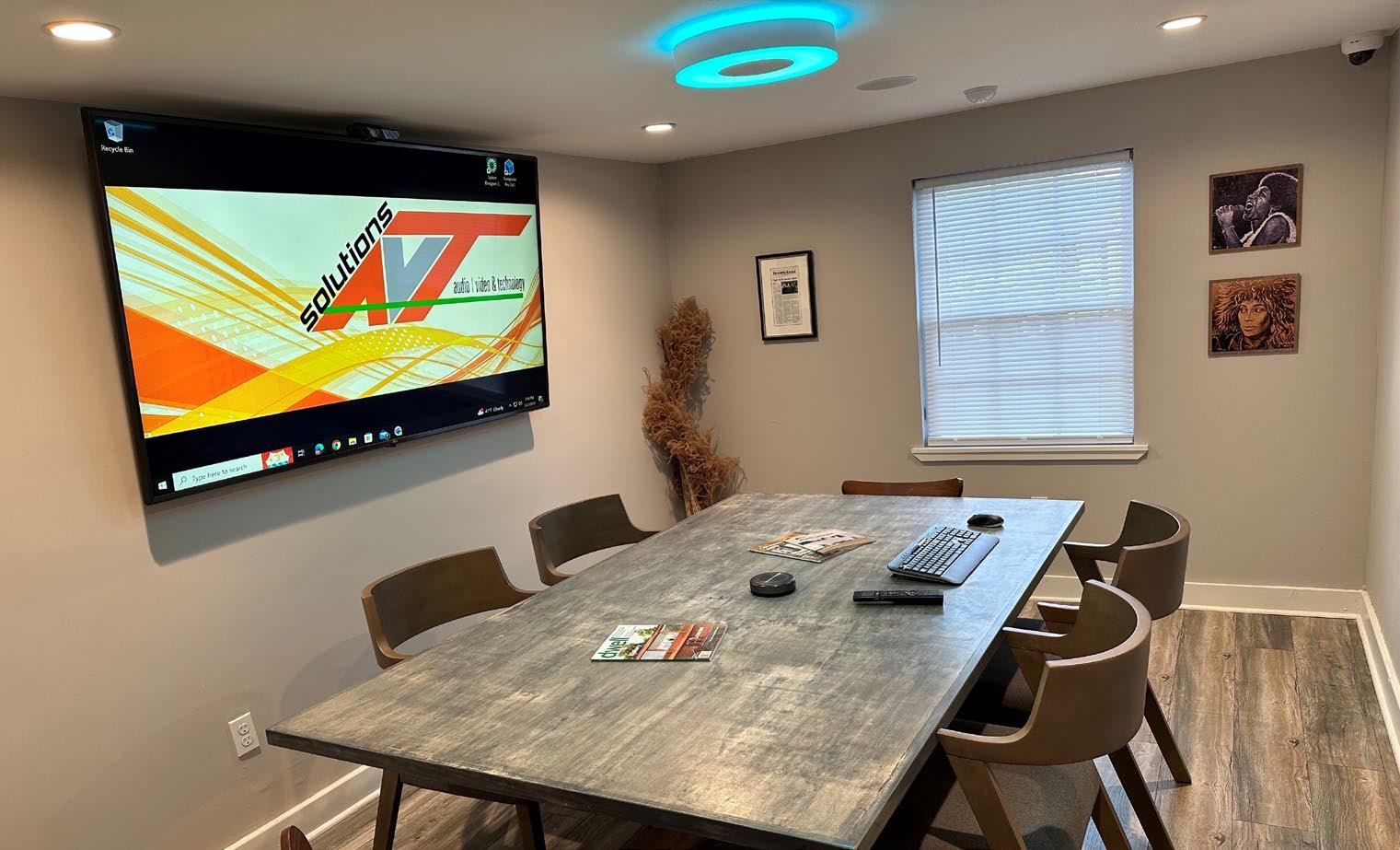

Website: immersiveinstalls.com
Location: San Francisco, Calif.
Showroom Dimensions: 19 feet x 13 feet
Brands Featured: Theory Audio Design, LG, Pioneer DJ, Acoustimac Panels
Fun Fact: Based in San Francisco, Immersive Installs caters to a distinct lifestyle, where the average million-dollar, single-family home has less than 1200 square feet. This introduces challenges for home theater enthusiasts, where compromise is the name of the game. The dedicated movie room typically gives way to a mixed-use design. Our demo room embraces a mixed-use concept that includes a gaming table for PlayStations, a DJ booth to entertain adult friends, a corner with several retro arcade games, and — let’s not forget — storage!
We’ve been known to host more than a few late-night dance parties for our close friends in this space. The speakers and amplifier controller from Theory Audio Design effortlessly transition from movie night to nightclub!
Website: solutionsavt.com
Location: Reading, Penn.
Showroom Dimensions: 1400 square feet
Brands Featured: Nice, Control4, Josh, Totem, Paradigm, Leon, Episode, Denon, Music Hall, AudioControl, Lutron, DMF Lighting, Electric Mirror, American Lighting, Touchstone, Clara, WattBox, Denon, Autonomic, CIS Networks, Samsung, Sony, LG, Atlona, Intellipure, Airthings, AprilAire, Phyn, ELK
Fun Fact: When we acquired the property, the mature trees in the front had low branches growing into the building and out through the roof. If this place wasn’t a Breeze Block box, it would have fallen over years ago!
Website: pacificdesigncenter.com
Location: West Hollywood, Calif.
Brands Featured: Coastal Source, Barco, California
Audio Technologies, Christie Digital, Cineak, Cinematech, Cisco, Control4, Crestron, Delta Light, Digital Projection, Fortress, Future Automation, Guilford of Maine, Kaleidescape, Lutron, Middle Atlantic Products, Panasonic, Planar, Ruckus, Samsung, Savant, Screen Innovation, Séura, Sonance, Sony, Steinway Lyngdorf, Stewart Filmscreen
Fun Fact: The AV Interiors “Studio 66 showroom” located in PDC Suite 66 is a luxurious space that demonstrates high-end home technologies and furnishings with a focus on audio, video, lighting, and smart home control, including a $1 million custom home theater. In March, Coastal Source became the first dedicated outdoor lighting and audio solutions provide r to have a presence at the epicenter of Southern California interior and outdoor design. The Coastal Source experience is located at the front of the showroom, ensuring every visitor gets to see a variety of lighting and audio solutions.
Website: www.savinc.net
Location: Bozeman, Mont.
HTA Certified
Showroom Dimensions: 2800 square feet
Brands Featured: Lutron shades including Palladiom and Palladiom keypads, Ketra, Axis Surveillance, McIntosh, Sonus faber, Sony, Samsung, Blackdove, Sonance Visual Performance and Invisibles, James Loudspeaker Landscape System, Josh.ai, Sonos, iPort, Leon Ente Tiles, Mikodam, Polycom Zoom room, Basalte Eve
Fun Fact: SAV Digital Environments elevated their showroom into an enthralling gallery space, dubbed "Medium," to showcase Ketra lighting solutions alongside state-of-the-art audio/video enhancements. This endeavor aims to immerse visitors with a multisensory experience, combining Ketra's advanced lighting technology with cutting-edge AV solutions to craft an authentically pleasing environment.




Sound Installation & Design Inc
Website: soundinstalljax.com
Location: Jacksonville, Fla.
Showroom Dimensions: 4400 square feet
Brands Featured: Epson, B&W, Lutron, Savant, Denon, Marantz, LG, Sony, Samsung
Fun Fact: The team here all have been a part of the team for 20 years — they must be having fun working here! The image on the projector screen is coming from an Epson EpiqVision Ultra LS800 4K PRO-UHD ultra short-throw 3-chip 3LCD smart streaming laser projector in black.
Elliston Systems & Design Experience Center
Website: www.ellistonsystems.com
Location: Dallas Design District, Dallas, Texas
Showroom Dimensions: The experience center is 3000 square feet and we have 7000 square feet of office/warehouse space
Brands Featured: Torus, Ascendo, Quantum Media Systems, Lutron, Ketra, Crestron, James Loudspeaker, Sony, Samsung
Fun Fact: The experience center has given our clients the ability to see, touch, and hear the latest in home technology, which has brought a lot of clarity to the daunting home building process. We also enjoy hosting lunch-and-learns and happy hours. Our $1M private cinema, featuring a Quantum Media Systems video wall and Torus torodial isolation power transformers, is always a showstopper.




Website: www.audioimpact.com
Location: San Diego, Los Angeles, Cabo San Lucas
HTA Certified
Showroom Dimensions: 5500 square feet
Brands Featured: Control4, Savant, Lutron, Crestron, Sonos, James Loudspeaker, JBL, Samsung
Fun Fact: We thrive on vibing on what we do! We are a 25-year family business.
Website : www.adgroupaz.com
Location: Scottsdale, Ariz.
Showroom Dimensions: 10,000 square feet
Brands Featured: RoseWater Energy, Crestron, Savant, Sony, Lutron, Paradigm, McIntosh, Sonus faber
Fun Fact: The showroom has changed the expectations of clients as they desire to experience all the services pre-build. The attraction is being able to group all of our clients’ needs within our technology to make their life choices seamless. The innovation within our marketspace is changing the industry. Our showroom was designed with this in mind.
The first nationwide custom integration franchise is quickly building momentum — and attracting top industry firms.By Anthony Savona
It was just a few months ago, at January’s CES 2024, that Daisy made its debut as the custom installation industry’s first nationwide franchise opportunity. (SaaviHome, the industry’s other franchise opportunity announced just prior to CEDIA 2023, covers the Mountain West region only at this time.) At launch, Daisy’s goals seemed ambitious; in its initial press release, the company stated it “will have numerous offices in California, Texas, Florida, Connecticut, and North Carolina by Q2,” and “expects to be in at least 16 markets in 2024, with a plan to be nationwide in 2025.”
In February, Daisy announced the addition of industry powerhouse Brilliant AV in Southern California, as well as the acquisition of an integration company serving Fairfield County, Conn., giving Daisy operations on both coasts. March rolled in with the announcement of a new franchise located in Sarasota, Fla., and the acquisition of Gordon van Zuiden’s well-established cyberManor in Los Gatos, Calif., putting the company in a good position to hit its Q2 goal.
 Hagan Kappler, CEO and founder of Daisy
Hagan Kappler, CEO and founder of Daisy
Daisy’s speedy success is due to its executive management team, which is steeped in franchise experience and is headed by founder and CEO Hagan Kappler, who previously led home-service franchising stalwarts such as ServiceMaster Clean, Merry Maids, and Threshold Brands. Daisy was created out of her professional experience and her own need for a home technology expert.
“On the personal side, I’m a mom of four kids and I’ve been running home services companies for the last six years,” says Kappler. “I felt more frustrated than I thought I ought to have been with my technology. When I looked at home automation, I thought what better space to drive an impact and be able to use my experience in home services while also meeting that personal need?
“As I started to learn more about the market, I discovered that it’s a $30 billion business, it’s growing really fast, and there is no national brand in the space. I think the consumer experience would improve massively if there was a brand here in the custom-integration market that was like Terminix in the pest-control space.”
The more Kappler met with integrators, the more she heard that, while they were aware that a recurring service is what clients were looking for, implementing such a model was difficult because of the small staffs that were bogged down with the day-to-day business.
“When I started to talk to integrators, I realized that they needed more help and support — the kind of support that you typically see in national brands and other home services companies,” she says. “So, the concept started to pivot from a mission of helping the consumer to also adding ways to help make the integrators’ lives better while proving the profitability in the growth and the overall value of their businesses.”
With the vision in place, Daisy started building its team. “We recruited pro-
fessionals with home services experience from Terminix and ServiceMaster Brands,” says Kappler. “We hired the head of growth from Crumbl Cookies, who’s heading up marketing for us, and then we hired folks from the custom integration industry. We started to build out ten different areas to provide support for integrators. We were also looking to identify flagship offices that could help establish the best practices and be flagships.”
For established businesses such as Brilliant AV and cyberManor, both of which will transition to the Daisy name and branding, being a Daisy branch is different from those starting a business from scratch. For one thing, the original owner remains heavily involved in the operations and client relationships.
“Our first goal is to do no harm,” says Kappler. “We are investing in these businesses for a reason, and we don’t want to do anything that will break them. We just want to add support. If that happens to be on the financial side, then that’s where we’ll dig in, but if they have a really savvy team and a really good office manager, we may put that part on hold and lean in on a recurring-service pilot instead. We have a turnkey system for anyone who wants to take advantage of that, but we’re not looking to cause any frustrations or problems for an owner. We want to make sure that things go smoothly during the integration process.”
With Daisy’s Q2 goals still within reach, it is continuing to investigate flagship offices. So, what exactly is the company looking for?
“We’re looking for really attractive markets where the dynamics are healthy and strong and where there’s going to be growth either because there’s a lot of new home construction or we just see trends that we like,” says Kappler. “Silicon Valley made a lot of sense for us. Orange County, the suburbs of Manhattan, and Florida are great markets as well.
“In terms of the actual business, we’re not necessarily honing in on a specific size — we think we’ve got the support that could help someone grow — but we look for a good group of people who are excited about being a part of Daisy. These are folks who tend to be in networking groups and benefit from being a part of that network. We think that’s important because it shows us that they’ll
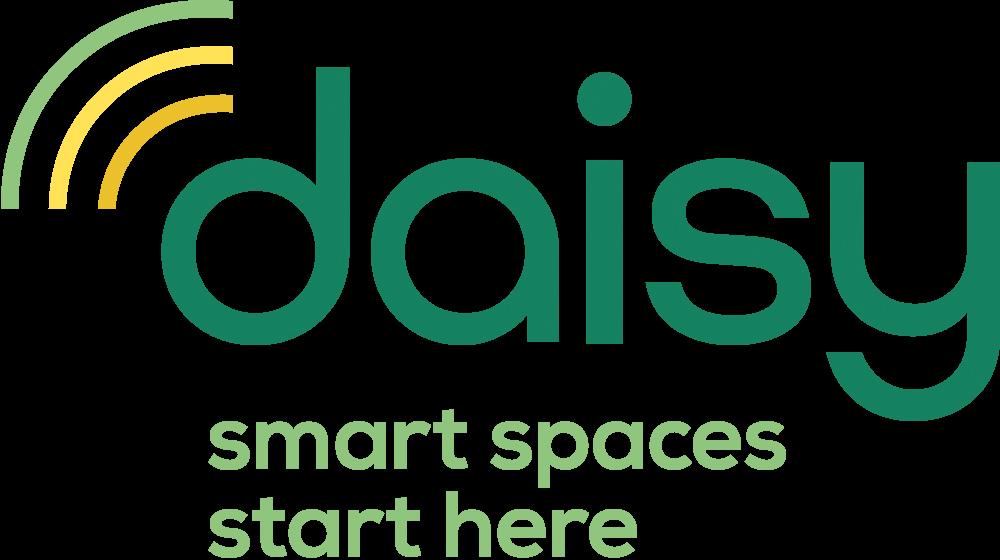
Daisy’s vision is to build a national consumer-beloved brand. It took the name Daisy because the team was looking for something that was approachable and friendly — how they hope consumers’ experience with their home technology can ultimately be. They wanted a name and a brand that people would see on the trucks and smile, or want to learn more about.
enjoy and thrive in a franchise environment.
“Finally, we look for someone who has aspirations. When we met CEO Matt Walin at Brilliant AV, he had his vision hanging on the wall, which was to be a national franchise brand in 10 years. I said, ‘How about 10 months?’ He signed the franchise agreement about nine months later. That kind of vision is important to us, especially the idea that they want to get better, because it’s one thing to have all the best playbooks and all the best toolkits, but you still have to hunker down and do the work.”
Those are many of the same qualities Daisy looks for in a new franchisee as well. “I think the new owners are likely going to fall into two categories,” Kappler explains. “First is someone who has some experience and background in technology and integration. That’s why our technicians become a great recruiting ground for us, because we can develop paths to get them to be owners one day. The second group is people who are business-savvy and who have some experience in the home services space. It’s someone willing to roll up their sleeves — they don’t necessarily need to be hanging TVs or running wires, but they are willing to help with dispatch in the morning and working on hiring and setting up some processes to ensure that the teams are successful.”
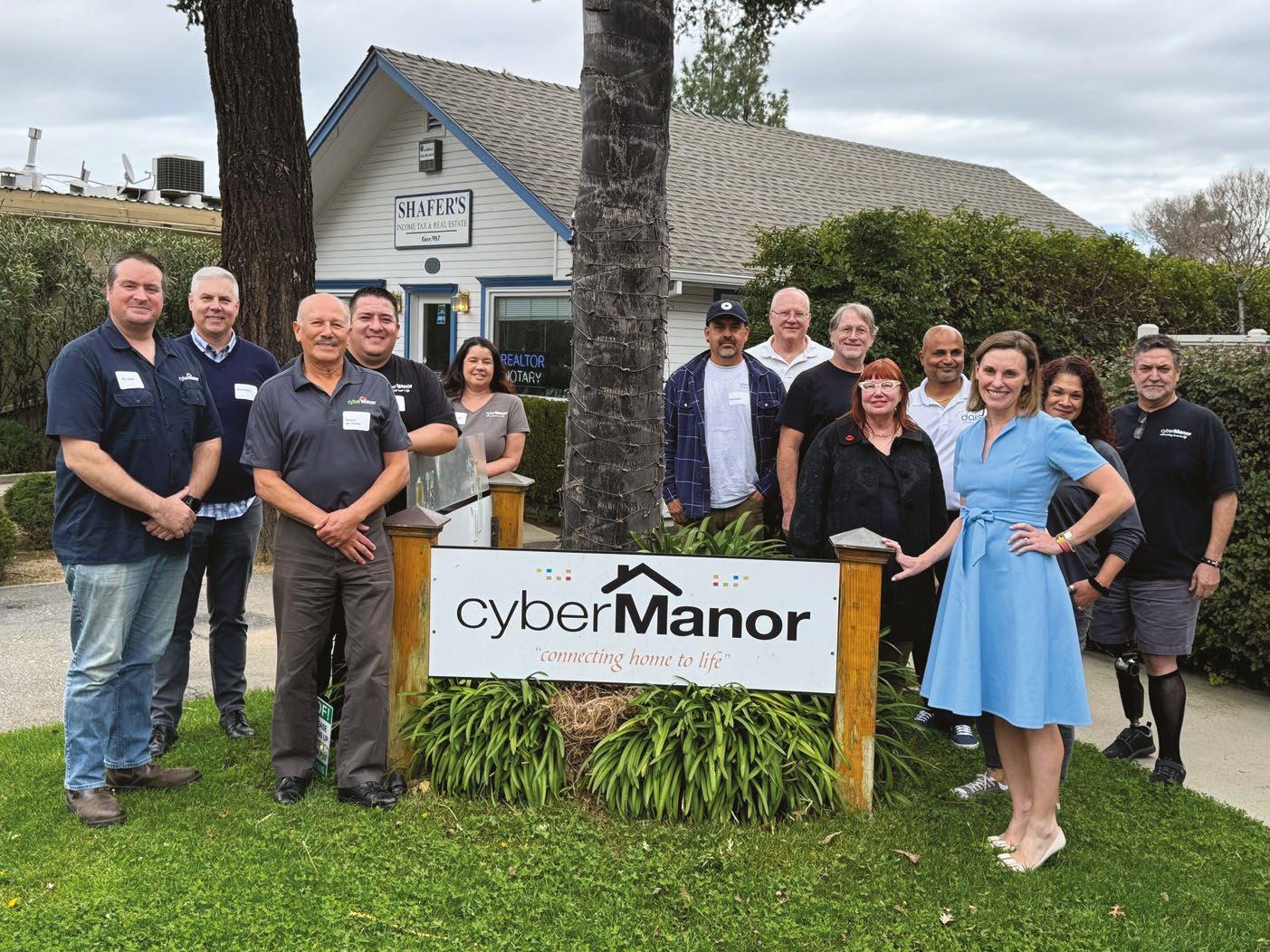
Starting a new Daisy franchise from scratch will require an initial investment of around $180,000 to $220,000. “When you join Daisy, you get the benefit of great coaches and a good team and good advice and the sort of professionals who will provide training and be ahead of what’s going on with manufacturers as you try to stay on top of key trends and technology upgrades,” says Kappler. “But what I generally find to be the greatest benefit in these kind of franchise networks is being able to ask someone who’s been in the industry for a long time how they do what they do. You get to share those learnings and have that nice feeling of knowing you’re not alone.”
Kappler encourages anyone interested in participating in a Daisy franchise to reach out to her or any Daisy employee on LinkedIn. There is also a form you can fill out at daisyco.com for more information.
For when audio is meant to be heard and not seen.
Architectural speakers play a big role in the current design-centric trend, where systems need to perform impeccably without calling any attention to themselves. Manufacturers have been supplying the market with many options that can cover almost any situation. Here we look at some of the latest entries to this popular product category.
The 3000 In-Wall subwoofer is the company’s first offering in the architectural subwoofer category. Generating massive sound pressure levels with accuracy and control are a pair of custom designed high-excursion 9-inch drivers built into a sealed aluminum and MDF cabinet that fits discreetly in the stud bay. Oversized motor design, custom-tooled basket, and rigid-yet-lightweight aluminum cones on the pair of active drivers are optimized for maximum acoustic output and thermal efficiency from a compact enclosure.

Arena 10 is the latest in-ceiling speaker of the new Sonus faber CI-FI collection. Arena 10 delivers fully immersive home theater Atmos experience through a 3-way speaker is equipped with four woofers, a 0.75-inch DAD tweeter, and a 6.25-inch midrange.
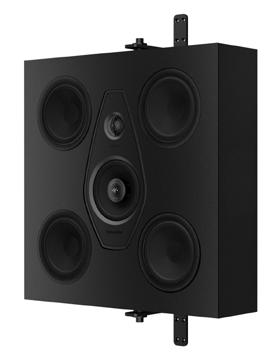
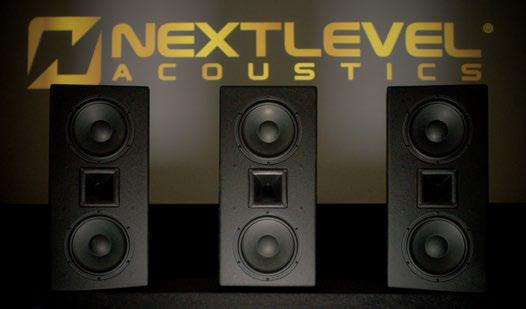
The NextLevel Acoustics Cinema Series consists of two models — the Reference Cinema (MSRP $2499 each) and the larger Cinema Pro (MSRP $4999 each). Using an MTM (midrange tweeter midrange) array, the Reference Cinema utilizes super light and stiff dual 8-inch carbon wool mid-woofers with a butyl rubber surround, and a large 4×4-inch compression horn tweeter. The Pro Cinema model is equipped with quad 8-inch carbon wool mid-woofers coupled to a 4×4-inch compression horn tweeter, bringing commercial-grade cinema performance to larger home theaters.
The Harman Revel PerformaBe Architectural Series is a high-end architectural speaker line designed to serve as a premium offering within the Revel brand. These speakers share the same components as the PerformaBe box loudspeakers, allowing for a shared sonic signature and the ability to mix them in a system. The Revel PerformaBe Architectural series includes three in-wall models
(W126Be, W226Be, W228Be) and one in-ceiling model (C128Be), which can be used as a complete architectural system solution or combined with existing PerformaBe loudspeakers to complement existing deployments or to create new and engaging installations.
The latest additions to the KEF Extreme Home Theatre range are the Ci5160RLM-THX and Ci3160RLM-THX. Ci-R Series speakers are built to the same exacting standards as R Series, which is a direct beneficiary of the technological innovations developed for The Reference, the class-leading series that continually set the benchmark for loudspeakers and sound reproduction. Incorporating a 12th generation Uni-Q driver array, both speakers feature KEF’s Metamaterial Absorption Technology (MAT), and carries the THX Certified Ultra designation — one of the highest THX performance classes.

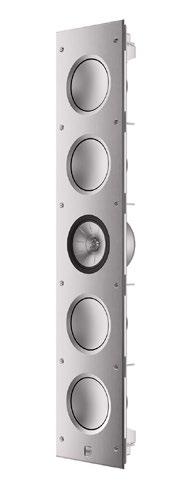
The Pro Audio Technology (PRO) SR-2408iw compact high-output architectural loudspeaker features a 1.5inch ring radiator tweeter, two high efficiency four-inch midrange drivers, and an eight-inch long-throw woofer. The SR-2408iw is a very high-output yet versatile loudspeaker suitable for in-wall and in-ceiling installations where space is limited but performance is crucial. At only 4 inches deep, and with all-aluminum construction, the SR-2408iw is designed for installations in yachts or elite home theaters (including DCI) as mains, sides, rears, surrounds, or as height channels for Dolby Atmos and other immersive audio installations.


Monitor Audio’s Creator Series features 19 models — 14 in-ceiling and five in-wall — arranged in three clearly defined tiers. Through Monitor Audio’s Partner Program (MAPP), extensive feedback from a wide network of experienced installers has been collected and analyzed. As a result, Creator Series is a more simplified range and accessory offering, ensuring performance levels are clearly defined, according to the company. Streamlined and enhanced technologies, naming, applications, and solutions, make the whole process of product selection much more straightforward for the integrator.
BLENDS is the collaboration between Origin Acoustics and Amina Technolo-
gies. The BLENDS series consists of two new invisible loudspeakers — Edge 8STS and Edge 10STS, featuring larger tapered edge panels that install direct-to-stud ready for prefilling, taping and filling — very different to Amina’s standard free-floating, fully skimmed over products. The Amina ALF100SM easy-to-install direct to stud mounted in wall subwoofer complements EDGE speakers by delivering powerful, room-filling bass while blending seamlessly into any home’s interior design with concealed ports that allow for truly discrete installations. Additionally, the BLENDS series includes the Amina EDGEi/S200 product for applications that won’t allow a screw-to-stud installation.


The Sonance Visual Experience Series features 21 models, including the Sonance VX and James VXQ models. Much like its Visual Performance series, the Sonance Visual Experience models range in performance to suit any desired performance and budget. Factoring into the performance options is the tweeter and driver material for each model in the series. Sonance has developed VX with flexible options for installation and trim style. The models will ship with a new Micro Trim grille as the standard option out of the box, with the option to order a Trimless grille, or even still, flush mount the speaker using Sonance TRUFIG Mounting Technology.
At the top tier of the line’s performance is the new James Visual Experience with Quadratech, VXQ. These models feature the all-new James Quadratech tweeter and Cymatic Diffuser.

The Paradigm CI Elite series has all the technology advantages of the company’s CI PRO Series and then some. The Aluminum Magnesium Ceramic (AL-MAC) tweeter is Paradigm’s unique blend of aluminum, magnesium, and ceramic materials; each of which contribute to the end goal of greater accuracy and realism. Their special properties contribute to the final product, which is not only strong and lightweight, but embodies a natural anti-resonance to ensure the tweeter doesn’t just sound good “on paper” but truly sounds incredible in the real world.
The Sonos 8-inch In-Ceiling Speaker by Sonos and Sonance provides installers and customers with a size option that sits discreetly within the ceiling and delivers powerful, balanced, and clear sound. The 8-inch In-Ceiling Speaker, designed and tuned in collaboration with Sonance, features a custom-built, enlarged woofer and high-excursion motor for a smooth midrange, deep bass down to 32 Hz, and a greater listening area. A 30mm tweeter and newly optimized waveguide ensures natural-sounding vocals and better high-frequency dispersion, for wide and even coverage that fills the room with sound.

The iws12-6 and iws12-9 are Theory Audio Design’s first architectural subwoofers. They are equipped with 12-inch, 1400-watt, 4-inch voice coil long throw
woofers, and the ability to be installed in-wall, on-wall, inroom, ceiling mounted or flown. The iws12-6 includes an enclosure that can be installed flush into 2x6 stud walls or surface mounted with only 5.5 inches of total depth. At 34 inches wide, 14 inches high, and only 9 inches in depth, and with an optional smart yoke bracket, the iws12-9 can be wall-mounted, ceiling-mounted, or flown. It can also simply be placed on the floor and used as an in-room subwoofer where a compact, high-performance subwoofer is desired.


The Totem Acoustic KIN IC62SST 6.5-inch, 2-way, in-ceiling speaker (MSRP - $685/ea.) features a Dual Mode that allows switching between surround sound for immersive cinematic experience and single stereo mode for confined spaces and/or secondary rooms where multiple loudspeakers are not possible. Its Ceramic Rotating Tweeters allows for placement in sub0optimal positions while focusing high-frequency detail to the listening position. It provides 30 degrees greater off-axis dispersion in surround mode, allowing greater coverage providing maximum detail and resolution. And with the Differentiated Crossovers for each tweeter, there is no cancellation effect given their close physical proximity.
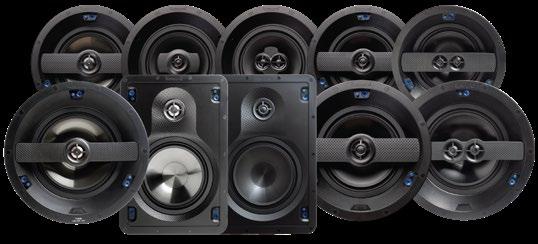
Designed to cater to various needs, the Russound IC-Series and IW-Series speakers provide a wide array of solutions suitable for any application, ranging from casual background music in relaxed settings to premium performance in dedicated listening areas. Recognizing the significance of seamless installation, Russound has integrated features to simplify the process. The inclusion of Easygrip tweeter posts and bridges facilitates hassle-free handling of speakers, even at the top of a ladder. Additionally, for premium models like the IC-620, IC-620T, IC-820, IC-820T, IC-630, IC-830, IW-620, and IW-630, Russound has introduced its proprietary SwiftLock technology, enabling effortless installation with just the push of a button.
SoundTube Entertainment has expanded customization options with the availability of square grilles for its CM-BGM-II series in-ceiling speakers, as well as its IPD IP-enabled PoE in-ceiling counterparts. The new square grilles come in both black and white, providing integrators with versatility for aesthetic preferences. The SoundTube CM-BGM-II series of in-ceiling round speakers provide full-range sound and are designed for background music and paging applications such as in retail spaces, restaurants, and offices. The SoundTube STNet IPD IP-enabled PoE in-ceiling speakers offer similar audio performance with the added benefit of being Dante and AES67 compatible to simplify installation and enable remote monitoring and control. With timbre-match sound, STNet IPD speakers ensure different mounting options can be combined to create a consistent audio experience.
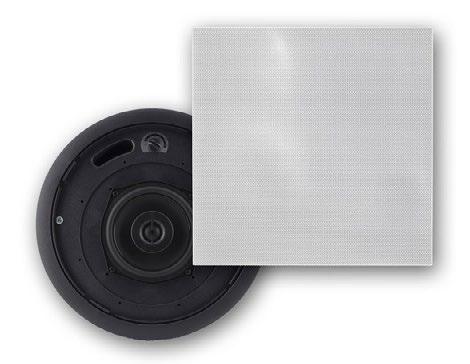

Dealers share some of their knowledge about the best ways to present lighting fixtures to trade partners and clients.
By Karen MitchellLet’s call it the after-buzz.
Lightapalooza 2024, held in Arizona’s Renaissance Phoenix Glendale Hotel & Spa from February 26–29, generated lots of electricity, and lights don’t dim just because the curtain goes down (unless programmed that way). Savvy integrators invested in lighting fixtures know how to pitch it to trade partners and homeowners.
“One of the biggest Lightapalooza takeaways, and one that we immediately implemented, is that we are not just custom integrators,” says Kristin Reinitz, coowner, Admit One Home Systems & Aurora One Lighting, an American Lighting dealer in Edina, Minn. “We are consultants and designers first, and need to present ourselves that way, especially when speaking of lighting.”
Her company is very much in the education phase right now, she adds. “One of the best things we can teach our partners is to think of lighting control, motorized shades, and lighting fixtures as one system. Lighting control and fixtures work (or don’t work well) together. Think of us as consultants, someone who will be there every step of the way. We can and do specify, produce drawings, and procure products, as well as arrange for material delivery, manage projects, and install. We are the experts in this area and a trusted source and partner.”
“One of the biggest Lightapalooza takeaways, and one that we immediately implemented, is that we are not just custom integrators. We are consultants and designers first, and need to present ourselves that way, especially when speaking of lighting.”
—Kristin Reinitz, Admit One Home Systems & Aurora One Lighting

Brian Anderson, Cyber Technology Group, a Lutron dealer in Scottsdale, Ariz., says Lightapalooza was truly invigorating. “It showcased the vibrant momentum from both the manufacturing and integration efforts of the lighting industry. Lighting constitutes a fundamental aspect of our projects, with clients interacting with these systems on a daily basis. What struck me most was the shift in client expectations; optimal lighting that enriches the space is now regarded as a fundamental necessity rather than a luxury. It underscores the importance for us as industry experts to continually educate and proactively engage in the evolving landscape of lighting, ensuring that we consistently deliver elevated experiences within residential spaces.”
His company’s approach to pitching lighting revolves around demonstrating the transformative power of lighting and its capacity to create ambiance within a space. Recognizing that experiencing lighting firsthand is essential to truly grasp its transformative effects, Anderson extends invitations to industry partners and clients to visit his showroom where he showcases the diverse array of possibilities available and emphasizes how these systems can significantly enhance the clients’ daily experiences.
“Central to our strategy is leveraging in-house architectural lighting design expertise and precise specifications to craft tailored solutions,” he says. “We prioritize fostering collaboration with our trade partners, providing comprehensive support and educational resources to raise awareness about the latest innovations in lighting. Through this approach, we aim not only to meet but exceed the expectations of both trade partners and homeowners alike.”
A Lightapalooza takeaway for Joe Stay, systems designer, Hoishik, a DMF dealer in the Greater Philadelphia region, is that dimming at the fixture level is now the dominant trend. “Lighting control and fixtures are changing rapidly, with so many options that it’s very difficult to keep up,” he says. “This is why an architectural lighting designer should be involved in projects. We work with premier architectural lighting designers, such as Adaptive Design Group. We are a part of the modern design team and use a collaborative approach. This approach allows us to provide lighting designs that we know will meet the design team’s and the client’s expectations. Our team works daily to stay on top of the latest technology. Many electricians don’t have the desire to support the technology that is now included in the lighting fixtures.”
“Our team works daily to stay on top of the latest technology. Many electricians don’t have the desire to support the technology that is now included in the lighting fixtures.”
—Joe Stay, systems designer, Hoishik
DMF’s Artafex 2- and 4-inch lighting fixtures with DALI-2 dimming offer great flexibility and functionality while keeping costs lower compared to some other options, Stay says. “Providing options like warm dim, tunable white, or fixed color temperature can enhance the ambiance and functionality of a space, allowing you to cater to your clients’ specific needs and preferences. It’s always a win-win when you can offer high-quality solutions at a more affordable price point. Artafex’s remodel fixtures provide greater flexibility for installation in various challenging spaces, making them a valuable addition to our product lineup.”
At Cyber Technology Group, the team loves integrating Lutron’s intelligent lighting solutions into residential projects, with a particular focus on Ketra and its digital HomeWorks solutions, Anderson notes. “These systems offer remarkable flexibility, allowing us to adapt seamlessly to homeowners’ evolving needs. Gone are the limitations imposed by traditional wiring configurations or static lighting color temperatures. Instead, these solutions empower us to create dynamic lighting environments that can be tailored to suit any occasion or preference.”
At Admit One, what’s considered the standard linear lighting from American Lighting is the Tuneable COB tape, which features uniform illumination (no diode hot spots) and is adjustable in color temperature, Reinitz says. “Following along the lines of where we see the industry going, the product we are most excited about is their Pixel Tape Lighting, which allows us to address individual LEDs, enabling
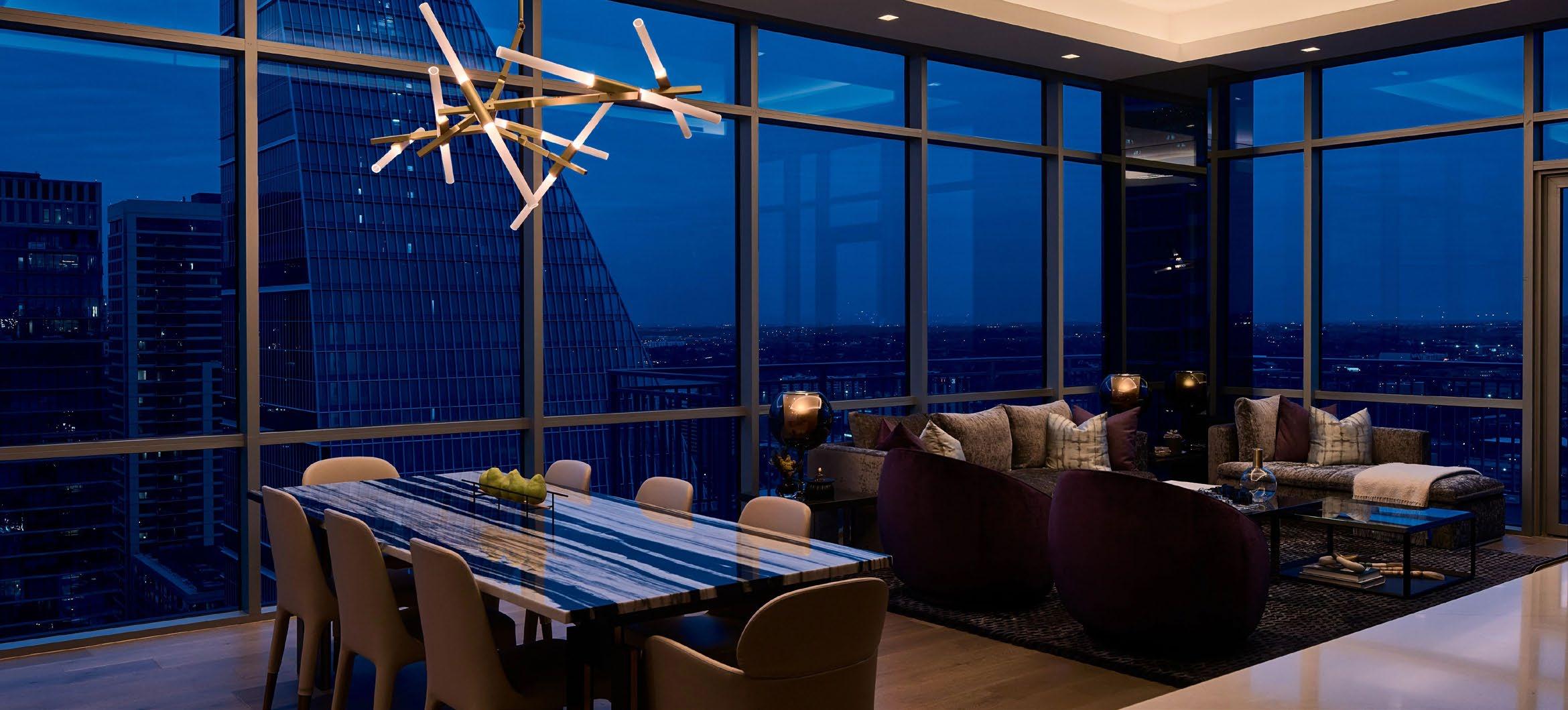

“What struck me most was the shift in client expectations; optimal lighting that enriches the space is now regarded as a fundamental necessity rather than a luxury. It underscores the importance for us as industry experts to continually educate and proactively engage in the evolving landscape of lighting.”
—Brian Anderson, Cyber Technology Group
independent control of dynamic color and design. The chasing or popcorn effect that can be created adds a layer of wow factor to a lighting design.”
The industry is moving towards an individually addressable, digital fixture vs. a traditional, load-based system, she adds. “Meaning that each architectural fixture can be manipulated in any zoning configuration within a specific room or property. Because of this, we are seeing DALI-2 being embraced in the residential market along with DMX. This allows us to be able to spec and install tunable white — the ability to select color temperature through programming versus picking a fixed bulb color temperature — as well as full color more easily. And linear (tape) is also being embraced as a light source (indirect) versus the traditional architectural fixture recessed in the ceiling.”





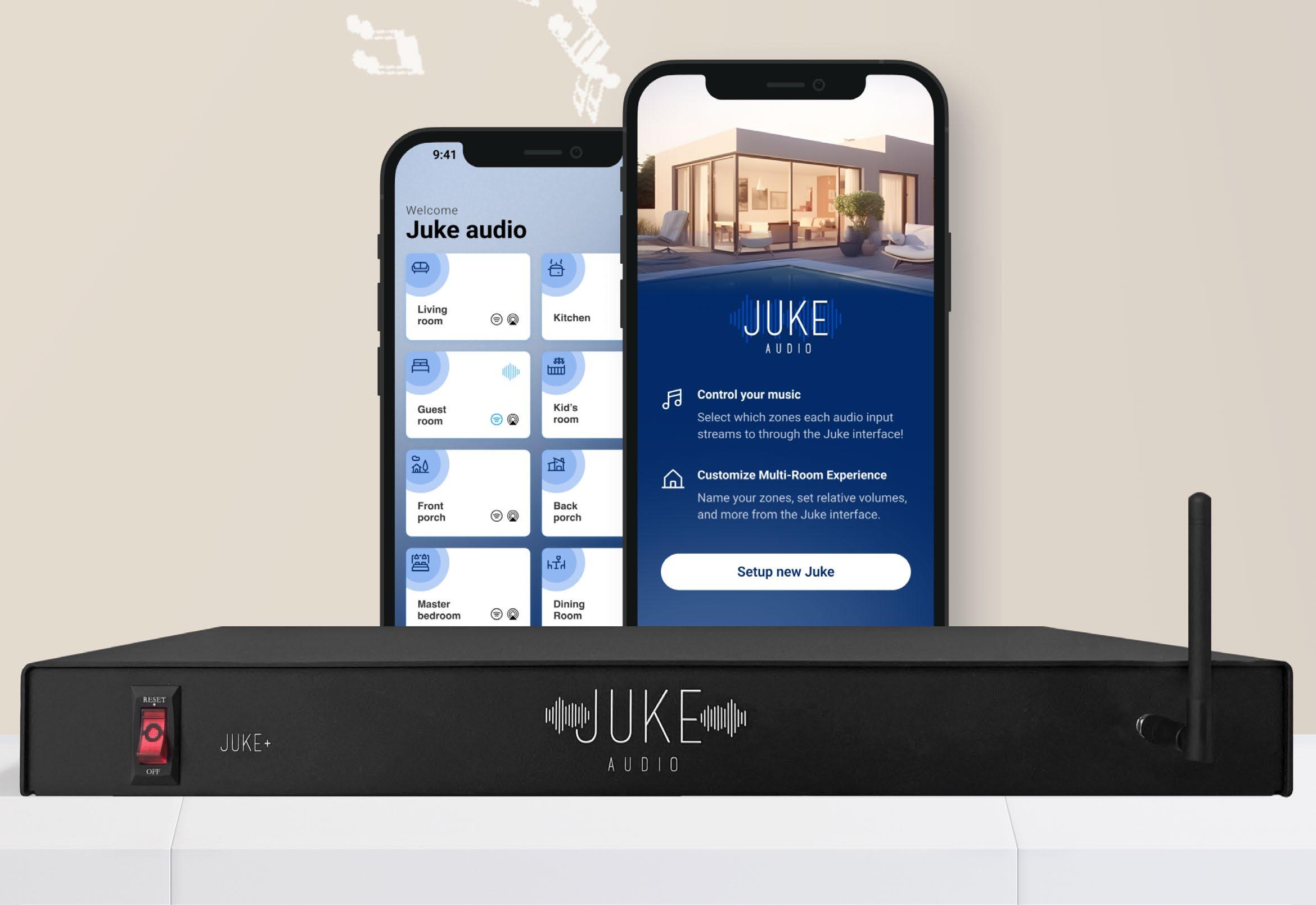
The Empire Strikes Back. The Godfather, Part II. The Dark Knight. Star Trek II: The Wrath of Khan. Dune: Part Two Sometimes, the sequel is just better. With a follow-up — especially when talking about an AV component — a manufacturer gets a chance to go back and improve things that didn’t quite hit the first time around. And if they’re smart, they will listen to the feedback of owners, dealers, and reviewers, taking the second goround to add features that were missing, fix any shortcomings, and upgrade performance that was lacking.
When I heard that Juke Audio was releasing its new Juke+, the successor to its Juke 6 (review available online), I had to see if they’d made it better.
Also, the Juke 6 review is by far-and-away the most clicked-on review I’ve written for Residential Systems. It frequently ends in the top stories every week, and it was the #3 most-read story on the site for 2023, a full two years after it was posted! So, clearly, we owed it to those people looking for fresh Juke information to bring in the Juke+ for a full hands-on!
Juke Audio’s motto is “Sound Made Simple,”
and that was definitely a big takeaway from my previous review, with just how simple it was to set up and use. The Juke+ expands on this idea, delivering an eight-zone house audio component that taps into streaming for its primary distribution, while still allowing expansion and easy integration with analog and digital sources. According to Juke Audio’s co-founder and president, Colton Forth, “This is an enhanced version of our older model, and comes with a lot of the key features dealers were asking for: higher power, audio EQ, digital and analog connections, additional streaming functionality, and so on.”
● Six stereo audio zones powered by 100 watts/channel (stable to 2-ohm), with Zone 7 RCA and Zone 8 Toslink
● Stream via Apple AirPlay2, Spotify Connect, Bluetooth 5, and DLNA
● Android and iOS App control
● Includes 5-band EQ adjustment for each zone
● Rack-mountable (1U) with included rack ears
● External Wi-Fi/Bluetooth antenna for increased range
● Connections: Inputs: RCA stereo, Toslink Optical, two USB-A, RJ45 Ethernet; Outputs: Six sets of detachable Phoenix connectors, RCA stereo, Toslink Optical, Detachable IEC power cable
● 17.13 x 1.75 x 8.38 inches (HxWxD); Weight: 7 pounds
In addition to this review, the Juke+ was also featured in the inaugural “Resi First Look” unboxing video. Forth joined me for a live chat as I opened the box and discussed my first thoughts, then went over some of the product’s features and the reasons for the changes. You can find that video on ResiSystems’ YouTube channel!
I’ve said it before, but when a company takes constructive feedback, adopts the suggestions, and produces a better product, it just warms my heart. It not only shows they care and listen to their community, but it also demonstrates that they are actually thinking about the product and customer experience.
If you went through and addressed my laundry list of criticisms on the first product, you’d essentially have the Juke+. Straight away, it’s a completely new and better

form factor. Gone is the odd-sized 15-inch width of the Juke 6, and now we are into a standard 17inch component width. The height has also been reduced to 1.75 inches (1U) and it comes with rackmount ears, making it more rack-friendly. Also, the Juke 6 just felt slight. I mean, it had 16 channels of amplification on board but weighed about six pounds. Though just a pound heavier, the Juke+ feels more substantial.
Where the Juke 6’s front panel has no buttons at all and is dominated by a Juke Audio logo with all the subtlety of a 72-point The New York Times headline, the Juke+ now has a front-panel power rocker switch and a detachable Wi-Fi/Bluetooth antenna. Granted, a front-panel antenna location is atypical; however, it makes perfect sense if this is going to be installed in a rack because you’ll [A] never see it and [B] will get improved range by getting the antenna outside of the metal enclosure. Juke claims the antenna gives a Bluetooth 5 range of up to 150 feet.
Around the back is where you’ll see the biggest changes and improvements. The Juke 6 only had speaker connections, which made it kludgey to add external sources. Sure, you could use either of its two USB-A connections to cobble together some USB-to-RCA analog inputs or a USB Bluetooth receiver, or use things like a Rockford Fosgate RFI2SW high-level RCA input plug and BOSS Audio Systems B25N ground loop isolator to connect an external amp or sub, but that was a totally a meh, MacGyver-type solution.
The new Juke+ includes a set of RCA inputs and outputs, along with a Toslink optical input and output, making expansion much easier and cleaner. The two USB connections are still there if you want to add additional analog inputs, but Juke tells me that a future firmware update will allow these to be used for connecting media directly to the system. Along with Wi-Fi, there is also an RJ45 Ethernet connection and a detachable power cord. Another big change you can’t see is that the
Juke+ has way more power than the 6. The wattage is now up to 100 watts/channel from the 6’s 40. With the 6, I found myself frequently listening up near max volume, and even then it was a bit lackluster when trying to drive my outdoor speakers or my large 10-inch Origin Acoustics speakers. With the Juke+ there is a lot more gas in the tank.
Not that you’ll need it, but there’s not a lot in the way of setup documentation included with the system. Inside the box is just a single Quick Installation Guide that basically says [1] Download the App, [2] Connect Juke to the network, [3] Connect the Speaker Wiring, [4] Configure your Device. (For the record, the wire code for 4-conductor wiring printed on the card is wrong; it has the right and left backward.)
The Juke+ doesn’t offer any hiccups in the way of install or setup, and if you’ve wired in a wholehouse system before, you’ll be right at home. For me, it was simply a case of disconnecting the speaker wiring from my existing Triad multichannel amp and wiring them into the Juke’s Phoenix connectors, swapping out some analog connections from my Triad audio matrix, and then connecting a network cable.
The Juke+ also supports 2.4 and 5 GHz Wi-Fi connections if hardwiring isn’t an option. To use, you go into your Wi-Fi list, select “JUKEAUDIO,” and then open the app to make a connection to your Wi-Fi network.
I fed the powered subwoofer linked to my kitchen zone from the Juke’s RCA output (Zone 7), and I used an analog output from my Dish Hopper to get TV audio around the home, along with a Toslink connection from my HEOS Link. If the Juke were located near a home theater system, its Toslink output (Zone 8) would be perfect to connect to an AVR that didn’t have any streaming capabilities of its own.
FOLLOW US twitter.com/resisys facebook/resisys CONTENT
MD, Content, AV Anthony Savona anthony.savona@futurenet.com
Contributors: Katye McGregor Bennett, Matt Bernath, Sam Cavitt, Henry Clifford, Dave Donald, Tim Fitzpatrick, Jason Griffing, Anthony Grimani, Karen Mitchell, Lisa Montgomery, Todd Anthony Puma, John Sciacca, Lisa Slayman, Gordon van Zuiden
Production Manager Heather Tatrow
Head of Design, B2B Nicole Cobban Art Editors Matt Lochrie & Rosie Webber
ADVERTISING SALES
Managing Vice President of Sales, B2B Tech Adam Goldstein, adam.goldstein@futurenet.com 212-378-0465
SUBSCRIBER CUSTOMER SERVICE
To subscribe, change your address, or check on your current account status, go to residentialsystems.com and click on About Us, email futureplc@computerfulfillment.com, call 888-266-5828, or write P.O. Box 1051, Lowell, MA 01853.
LICENSING/REPRINTS/PERMISSIONS
Residential Systems is available for licensing. Contact the Licensing team to discuss partnership opportunities. Head of Print Licensing: Rachel Shaw, licensing@futurenet.com
MANAGEMENT
SVP, MD, B2B Amanda Darman-Allen
VP, Global Head of Content, B2B Carmel King MD, Content, AV Anthony Savona VP, Global Head of Sales, B2B John Sellazzo Managing VP of Sales, B2B Tech Adam Goldstein VP, Global Head of Strategy & Ops, B2B Allison Markert, VP, Product & Marketing, B2B Scott Lowe Head of Production US & UK Mark Constance Head of Design, B2B Nicole Cobban FUTURE US, INC. 130 West 42nd Street7th Floor New York, NY 10036


At this point, the Juke+ is essentially set up and ready to play music. Open your preferred music app, get music playing, and then use AirPlay2 (or Spotify Connect) to send music to one or more of the Juke’s outputs. (Android users can use an app called “AirMusic” that can be used to connect to the Juke+’s AirPlay inputs, or use Bluetooth. Forth told me they plan to release additional support for Android streaming this summer.)
However, to personalize the chassis and unlock all of its features, you’ll want to open the new iOS or Android Juke Audio app, which has also seen big changes since my last review. (You can still access many of the Juke’s settings via a web browser.)
With the previous system, playing music on the Juke was kind of a multi-part affair, and often required opening a Web browser and navigating to “Juke.local” via iOS or the unit’s IP address via Windows/Android, picking which of the four available sources to play in a zone/area, then playing to that source. Now the app eliminates much of this, making access and operation much quicker and more intuitive.
In fact, Juke says its app only needs to be used sparingly. Forth said, “Our intention is to make it so the user needs to visit the Juke app as little as possible and just stream from the apps they already know how to use and love. The Juke app is intended to be used for setup/configuration, with light modifications made when needed.”
The app is used for things like labeling each zone, “hiding” any unused zones, setting maximum volume in each zone, adjusting a 5-band EQ in each zone (with frequency boost/ cuts at 250 Hz, 500 Hz, 2 kHz, 4 kHz, and 16 kHz), and enabling Groups (more on that in a bit).
By the time you read this, Juke’s app will have an update that will offer EQ presets and a selectable mono output feature per zone.
Behind a password-protected Admin page are more options, like managing zone settings, managing group input settings, network setup, diagnostics, updating firmware, etc. Part of the diagnostics is the ability to upload logs and enable Live Troubleshooting, which gives Juke techs “permission” to access and troubleshoot your system.
There are four configurable Groups, which is how Juke responds when a specific stream — RCA, Toslink, Airplay, Spotify Connect, Bluetooth, and DLNA (up to 32-bit/48 kHz) — becomes active. You can configure a zone or group of zones to automatically turn on and start playing when the Juke+ senses that audio from one of these streams becomes active.
Forth told me, “We've implemented a protocol of inputs that is ‘last come, first serve,’ meaning that once a new audio stream is detected, it will take control of the zone regardless of whether another stream is playing in it or not.”
This is a fantastic way to use the Juke+ with your TV’s audio — or any other source you want to have priority — automatically kicking on and activating any zones desired when it senses that audio input. And if two or more active streams are trying to play in a zone simultaneously, you can switch between them using the Juke app. (Note: The Juke can only take PCM audio, not a bitstream.)
If the six onboard powered zones along with the RCA and Toslink outputs aren’t enough, Forth says that multiple Juke+’s can be used together, and they have multiple four-Juke+ systems installed out in the wild, though it is important that they all be hardwired to the network (not Wi-Fi) to prevent any delay between the units.
The Juke+’s strength is its ability to get people
to quickly and easily listen to the music they want to hear, where they want to hear it. By leveraging AirPlay (and Spotify Connect), people can use an app they’re already comfortable with and then just select which zones to listen in and adjust the volume accordingly. Want to add/delete/change rooms? Just click a bubble. From that standpoint, the Juke+ was basically out of the way and doing a great job. And, unlike Bluetooth, I love how AirPlay2 allows you to still use your phone for whatever you want — play games, make calls, watch videos — without disrupting the audio stream.
For the most part, I left the Juke’s zone output volumes at max, then adjusted the level I wanted for each zone within AirPlay. If a source sounded a bit hot and leaned into distortion, I’d lower the Juke’s volume output a bit.
You can route any stream — AirPlay, Spotify, Bluetooth, RCA, Toslink, DLNA — to the Juke’s Output 7 (RCA) and 8 (Toslink). When using AirPlay/Spotify, you select, control, and even pair these zones just as you would any of the powered outputs.
I definitely noticed the increased power output of the Juke+ as well. It had no problems producing bass from my large Origin 10-inchers or driving my Monitor Audio outdoor speakers to more yard-filling levels (though I still needed to push it up near full volume). Even with bass-heavy tracks like The Crystal Method’s “High Roller” or the opening of Hans Zimmer’s “Beginnings Are Such Delicate Times,” the Juke+ was able to coax some real low-end from my in-ceiling speakers. Would I like the ability to be able to bridge zones together for even more power? Sure, especially for my outdoor zone. But it’s not a deal breaker.
I also loved the flexibility of the 5-band EQ, letting you tweak performance in an area to get the right sound. This lets me easily bump a little low-end in certain areas to get a little fuller low-
end from my 6-inch speakers. And since it makes adjustments in real-time, a homeowner could listen and dial the sound to his or her desire.
The Group feature worked as promised; when I’d turn on one of the Grouped sources, the Juke+ would dutifully switch to that new stream and start playing.

I did have a couple of issues with the Juke+, starting with the Niles CM4PR speakers in my kitchen. These are small (3.5-inch woofer) speakers, and I have four of them installed in parallel, which presents a 4.7-ohm load to the amp. While this impedance shouldn’t be a problem for the Juke+, which is rated down to 2 ohms, the Juke couldn’t “see” the speakers. Instead, it showed that nothing was connected and when I tried to play something to the kitchen zone all I got was clicking.
Juke brought in a pair of the CM4PR’s to test and found that the internal coupling is different than for typical speakers, such that the Juke+ measured an unusually high speaker impedance at lower frequencies, which it treated as an open load. The Juke tech support team was able to change the firmware to avoid this issue, making the Juke+ detect the speakers properly, and get them to work.
I also had some challenges getting the RCA inputs and outputs to work in my setup. My plan was to connect my Dish Hopper to the Juke’s RCA input so I could listen to TV audio around the house, but the audio was very garbled and distorted, making it unusable. I then tried the analog output from my HEOS Link and had the same result. With the RCA output, I wasn’t able to get any audio from my connected subwoofer, even when playing the outputs at max.

Juke sent a second unit for me to test, and after it exhibited the exact same results, I decided to take the Juke+ into my CI showroom, where I had more equipment at my disposal to test with.
In my showroom, I connected a CD player, the Victrola Carbon HiRes turntable, and a
Sonos Port, and I was able to get them all to play with no problem. However, I could induce the distortion by putting the Sonos’ output to fixed.
My guess is that the RCA input is very sensitive to the input level it receives, and it distorts signals that are outside the range it is looking for. While I could lower the output level of my HEOS Link, there was no adjustment available for the Hopper’s analog output, meaning I couldn’t get it to work.
Juke commented, “The ‘consumer audio’ linelevel standard is –10 dBV, which has a full scale of 0.894 volts peak-to-peak. The Juke+ RCA input has a full-scale input range of approximately 2 volts peak-to-peak, which is a nice compromise, given the various possible signals that may be provided by various devices to which it is connected. If a connected device has a dynamic range greater than 2 volts peak-to-peak, then an inexpensive signal attenuator can be inserted between the device and the Juke+ RCA input.”
I then connected the Juke’s RCA output to a Yamaha AVR and was also able to get it to play as well; however, I had to jack the Yamaha’s volume fairly high, especially with the Victrola. My guess is that the Juke’s RCA output level is much lower than the typical line level, and it wasn’t enough to register a signal to my subwoofer. With the Yamaha receiver having more headroom, I was able to raise its volume enough to get it to play, though the Victrola was only ever loud-ish, even with the Yamaha volume cranked.
Whether this is something Juke can address in firmware or not remains to be seen, however, if you plan on using the RCA connections, you might do some testing before the install.
With the Juke+, Juke Audio has stayed true to its “Sound Made Simple” philosophy while making a ton of improvements and upgrades. With many people relying on phone-based app streaming, the Juke+ gives six, powered AirPlay2/Spotify Connect zones to easily enjoy music around the home in a way they’re familiar with. This lets everyone listen to what they want, where they want, which is a total win for a whole-house audio system!
A reality check on one of the hottest — yet largely misunderstood — segments of the home systems business.BY JOE PICCIRILLI, CEO AND FOUNDER, ROSEWATER ENERGY
There’s also no doubt, after witnessing the impact of unstable, unreliable electrical power on the performance and longevity of smart systems, that electrical issues are reaching a state of serious concern. So why aren’t more integrators tackling the issue?
As we discovered during educational courses, panel discussions, and conversations with integrators, misconceptions and uncertainty about the power management category may be to blame for integrators’ reticence. Here, we aim to bust some of the common myths that may be inhibiting adoption of a very necessary, foundational element of today’s high-tech luxury homes:
Myth #1: My customers don’t want to spend money to improve the quality of power in their homes. According to the North American Electric Reliability Corp and as reported by the Washington Post, the energy demand in North America more than doubled from 221,000 kilowatt hours in 2022 to 564,000 kilowatt hours in 2023. Driven by the rapid innovation of artificial intelligence and the development of new data warehouses, the growth is putting a noticeable crimp in the aging power grid.
If you or your customers think power is not an issue, consider observations from Wisconsin Power after extensive research of its grid: “Power quality problems can affect many appliances in your home, especially electronic equipment dependent on microprocessors. Computers, stereo systems, satellite receivers, and other appliances may be damaged or may fail prematurely if they are not protected from harmful voltage changes and related disturbances.”
There’s a reason your customers invest handsomely in lighting control, automation, AV, and other tech amenities — it enriches their lifestyle. So, too, does a power management system that keeps the entire home operating optimally.
Myth #2: Surge suppressors mitigate most of the issues, so why do anything more? Certainly, protecting equipment from damaging electrical surges and spikes is important, and surge suppressors do a good job of this, but many other facets of electrical power must be addressed to ensure optimal performance and longevity of every system in the house. For example, an independent surge suppressor may be a good solution if your client’s only concern is protecting the home office equipment. A separate power conditioner has its place, too, often commissioned to regulate the voltage in a high-end home theater. But today, more than ever, consumers need a complete solution that conditions, cleans, and stabilizes incoming electrical power as it protects against damaging grid anomalies and keeps all devices and systems — not just a select few — operational during a power outage. A comprehensive approach to power quality assures customers that no matter what happens on the electrical grid or what Mother Nature dishes out, the downtime associated with power issues is eliminated.
Myth #3: Power management doesn’t allow for customization. Just as solutions for lighting control range from a simple dimmer to a whole-house system, so too do products and systems that improve the quality of electrical power in a home. Your job is to determine what your clients are most concerned about protecting from fluctuating voltage, damaging electrical disturbances, and power outages and build a power plan around it. For example, a wine collector might be only concerned with maintaining a safe temperature in the wine cellar during an outage, while another family wants every system in the house to remain operational. Others might want to mitigate issues with their AV equipment and ensure their expensive, customized lighting system works without fail. These differing needs translate to varying degrees of power management.

Myth #4: I need an electrician on staff to install a power management system. A power management system sits on a home’s electrical lines, so, yes, a licensed electrician is required for hookup. However, this doesn’t mean you need this professional on staff. In fact, you won’t need to commit any additional resources at all to the commissioning of a power management system — as long as you align with a manufacturer who will handle it for you. A manufacturer that offers white-glove service and support will specify the proper equipment for the application, design and configure it appropriately, deliver it to the jobsite, and work collaboratively with all building professionals, including the electrician, to ensure the system meets all customer expectations.
Myth #5: Power management is unprofitable. Au contraire. With the support of an experienced, well-established manufacturer of power quality solutions, power management can be the most profitable part of your business. Why? Because, unlike other emerging categories, it allows you to easily scale dollars per job. Just one sale of a whole-house power management system adds significant revenue. The system is commissioned completely by the manufacturer, so there’s no need to allocate resources. Moreover, once the system is up and running, you’ll realize a huge reduction in costly service calls.
If you’d like to learn more about the state of electrical power in the U.S., its impact on home technology and systems that deliver clean, reliable electrical current to all the systems you design and install, please visit www.rosewaterenergy.com.

